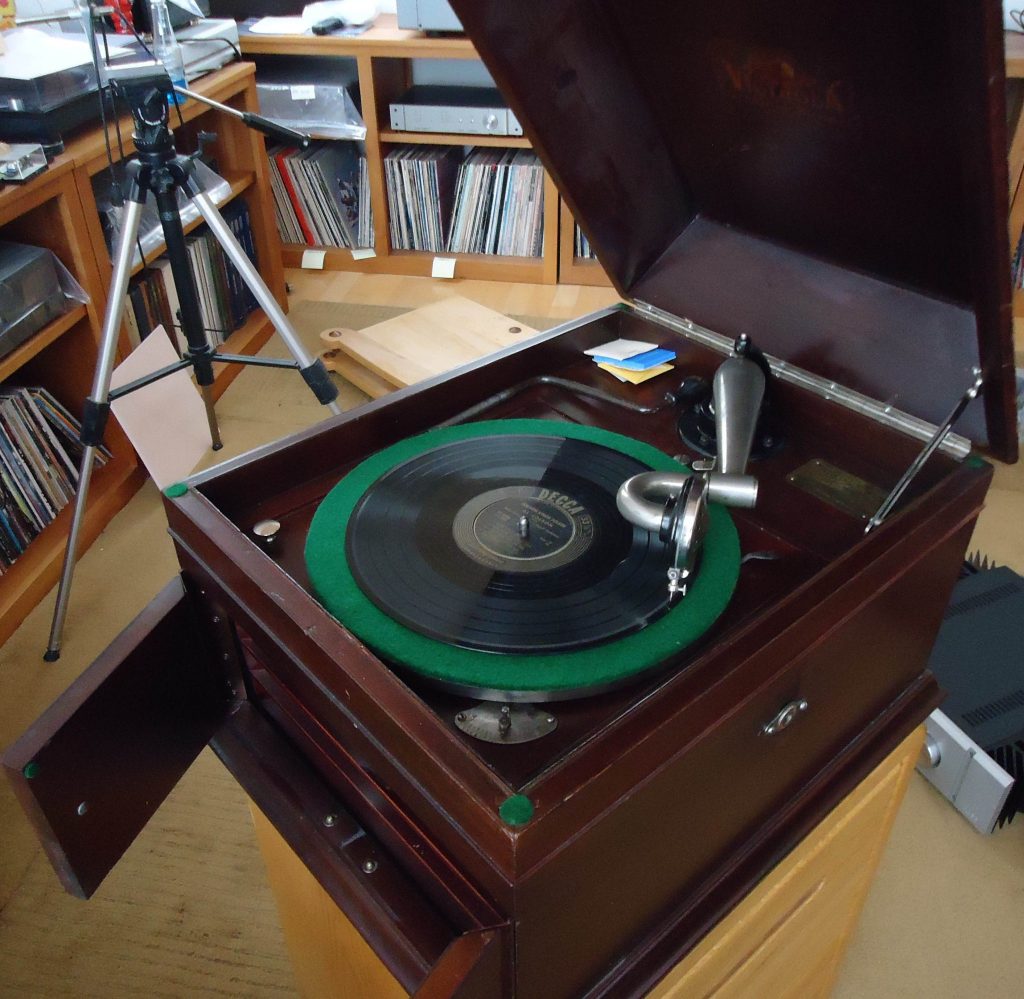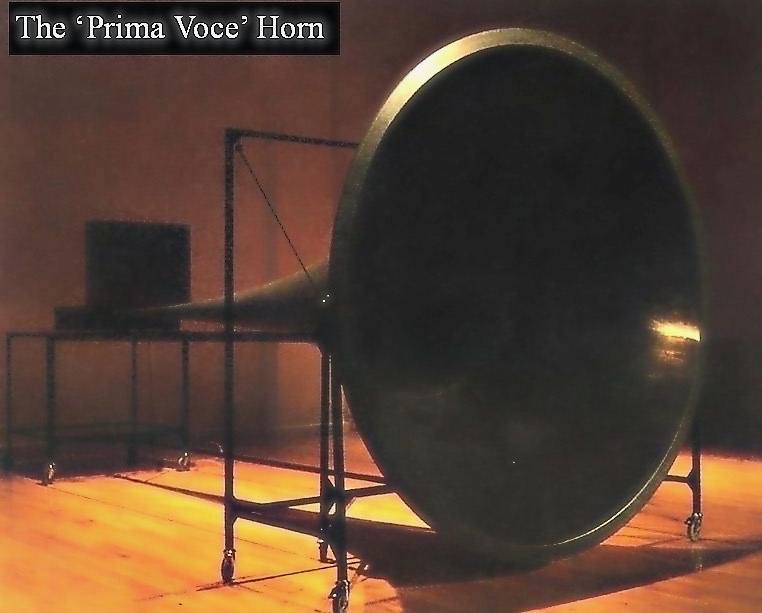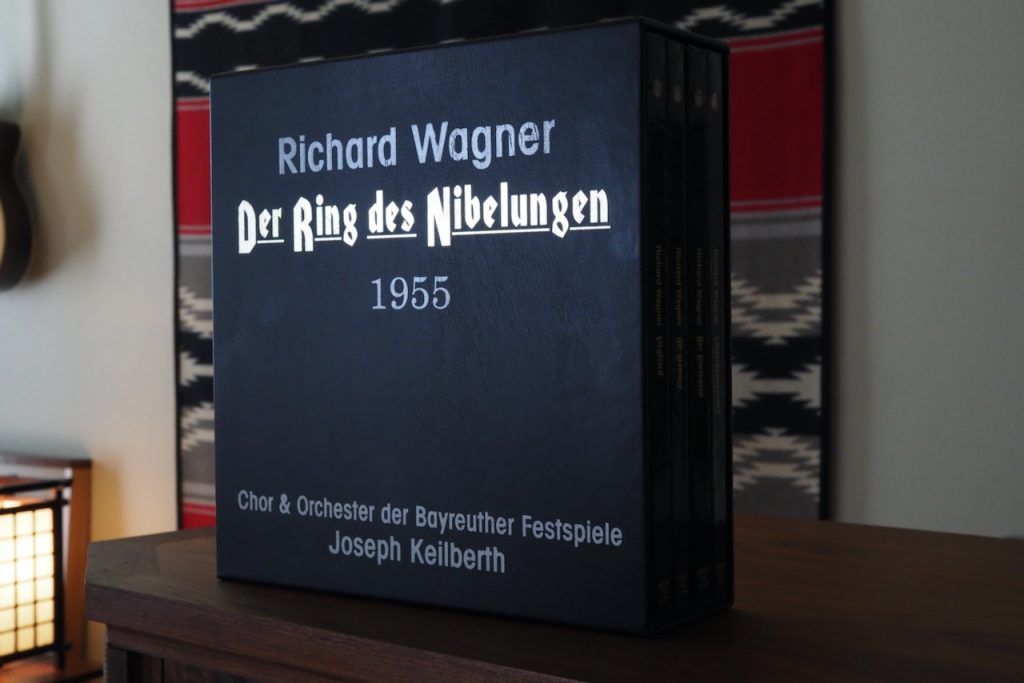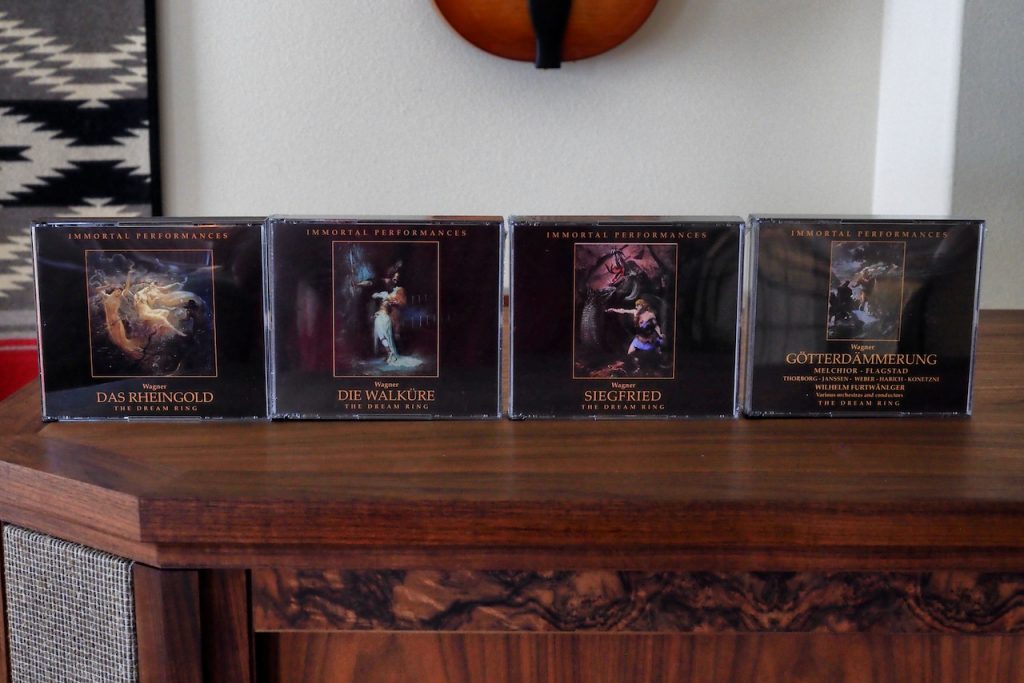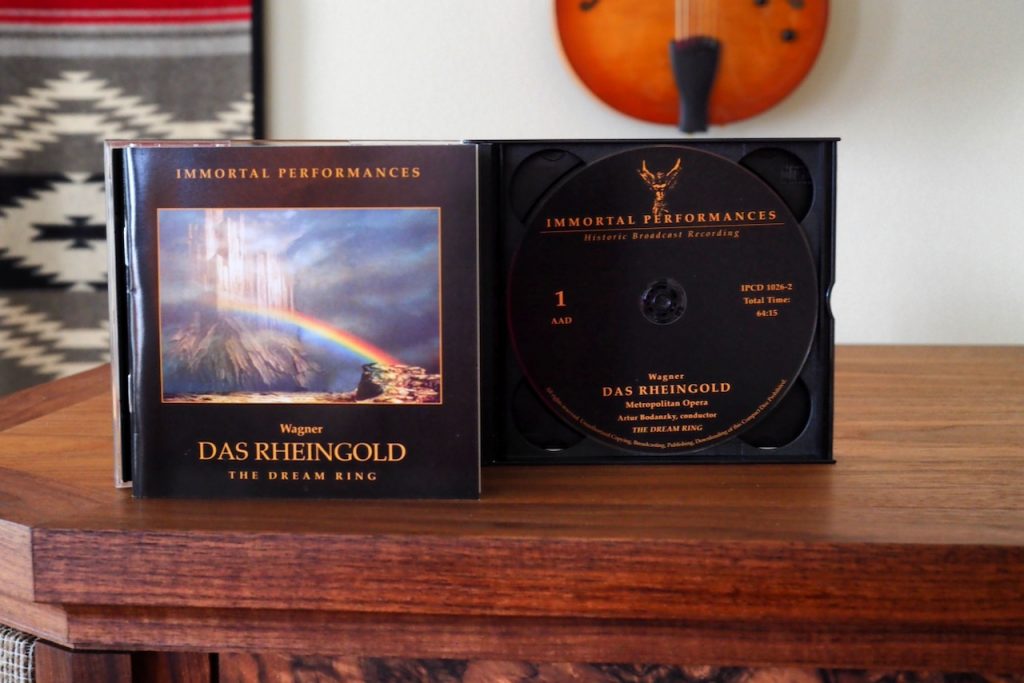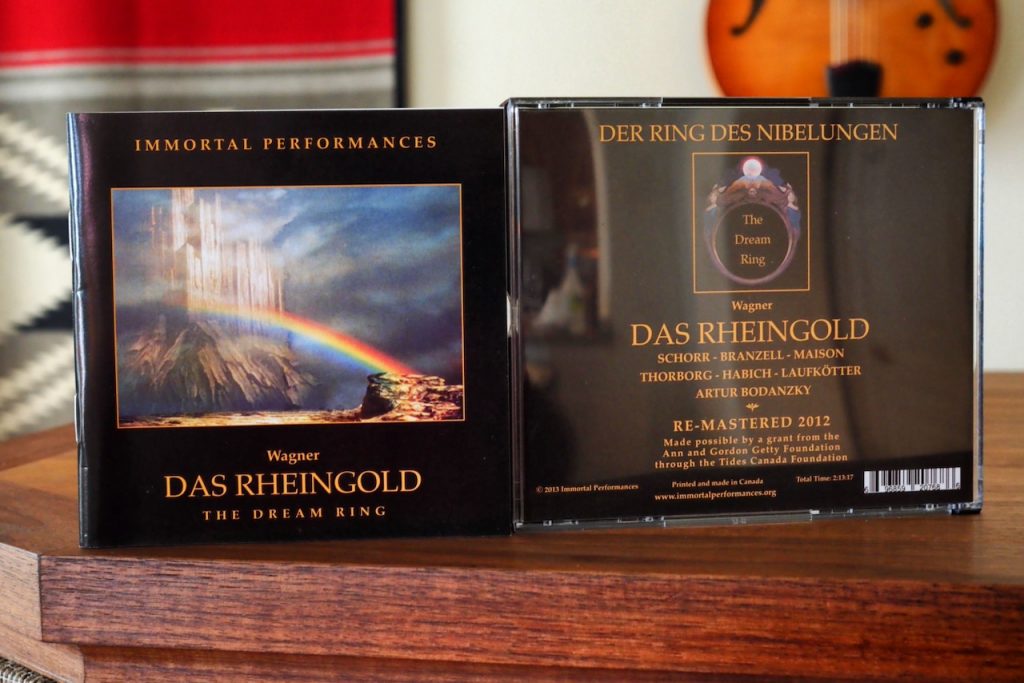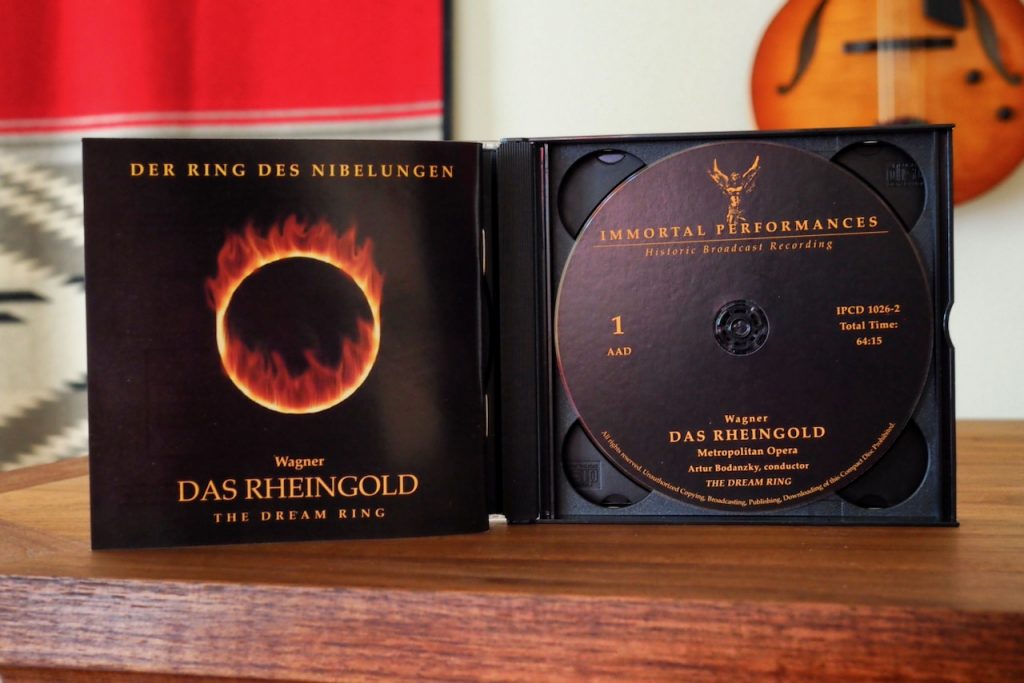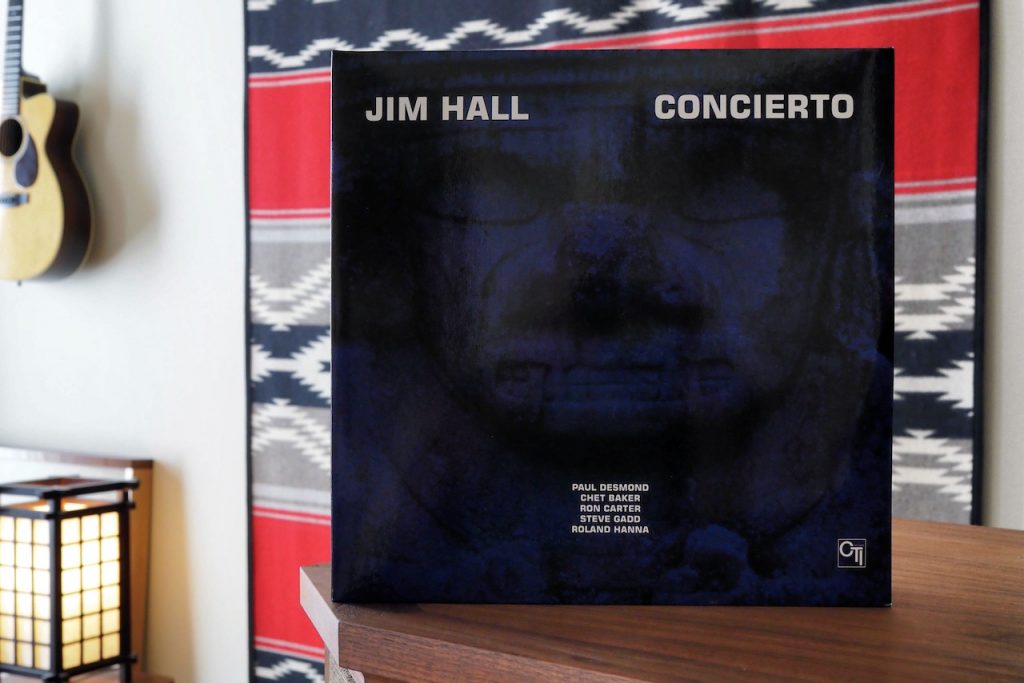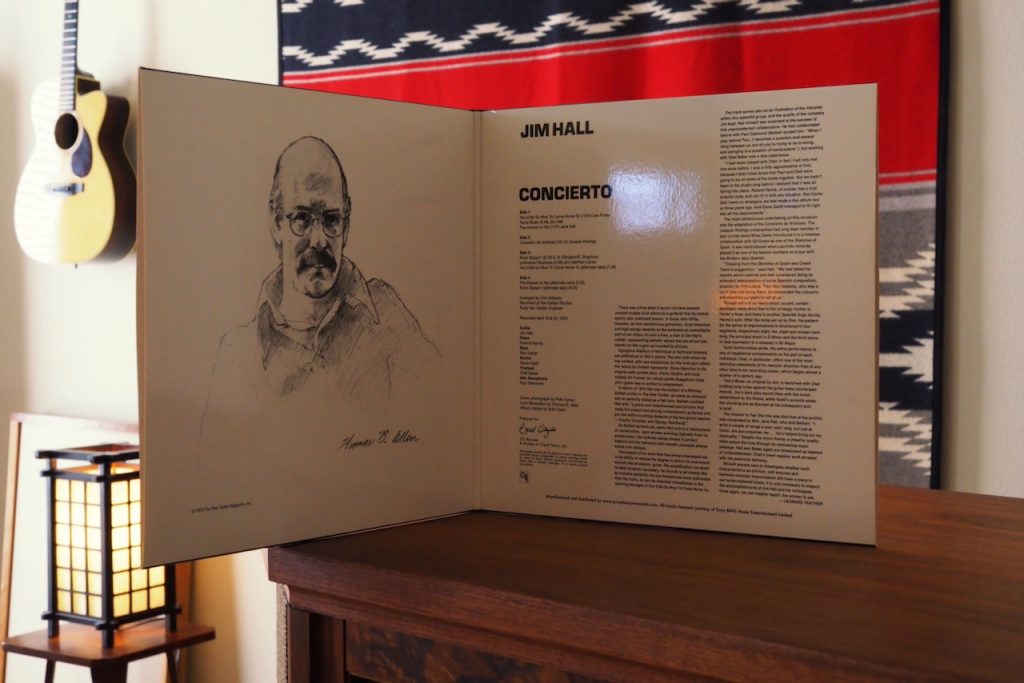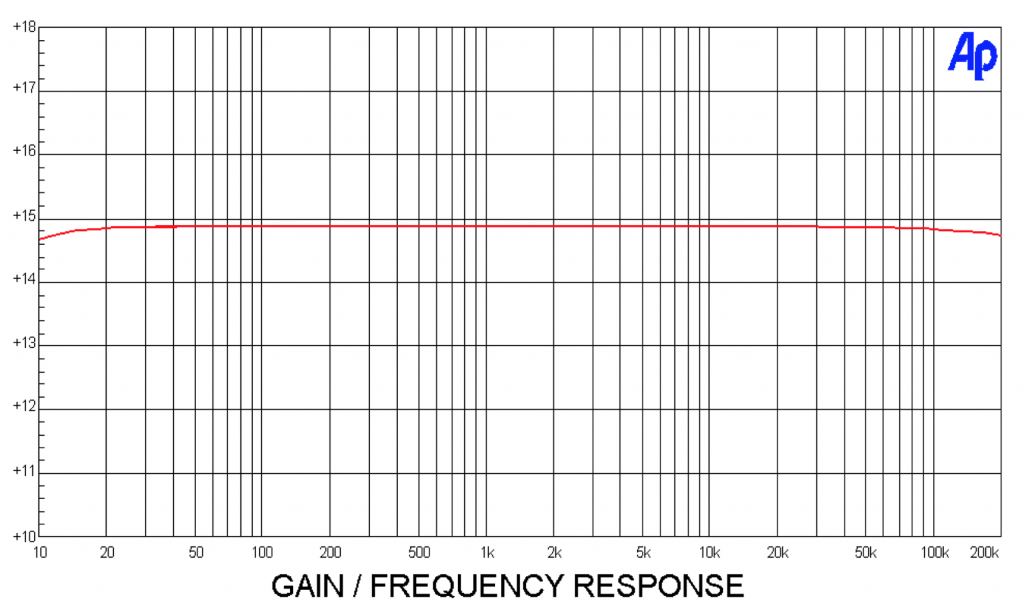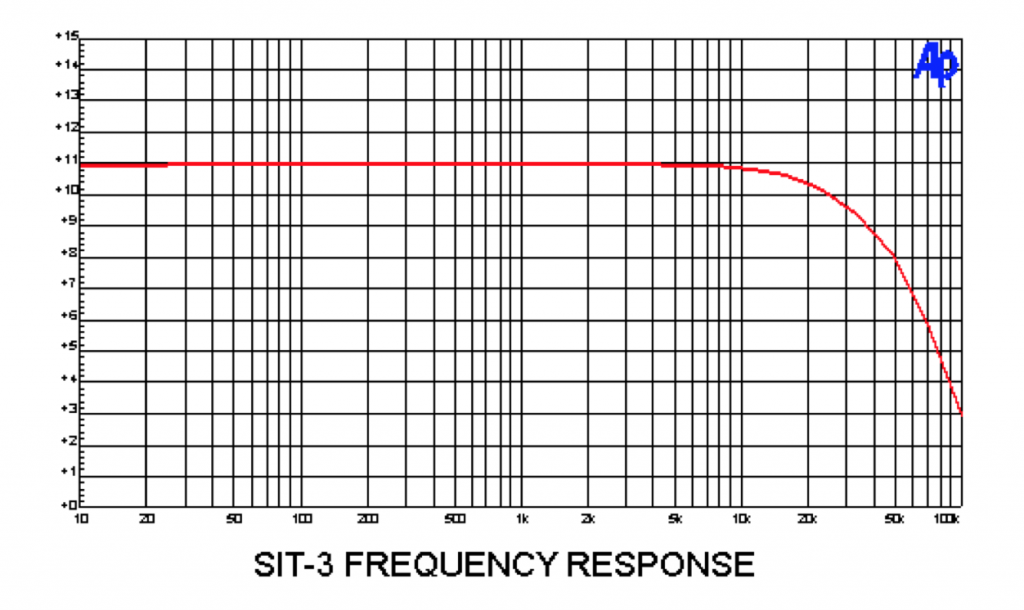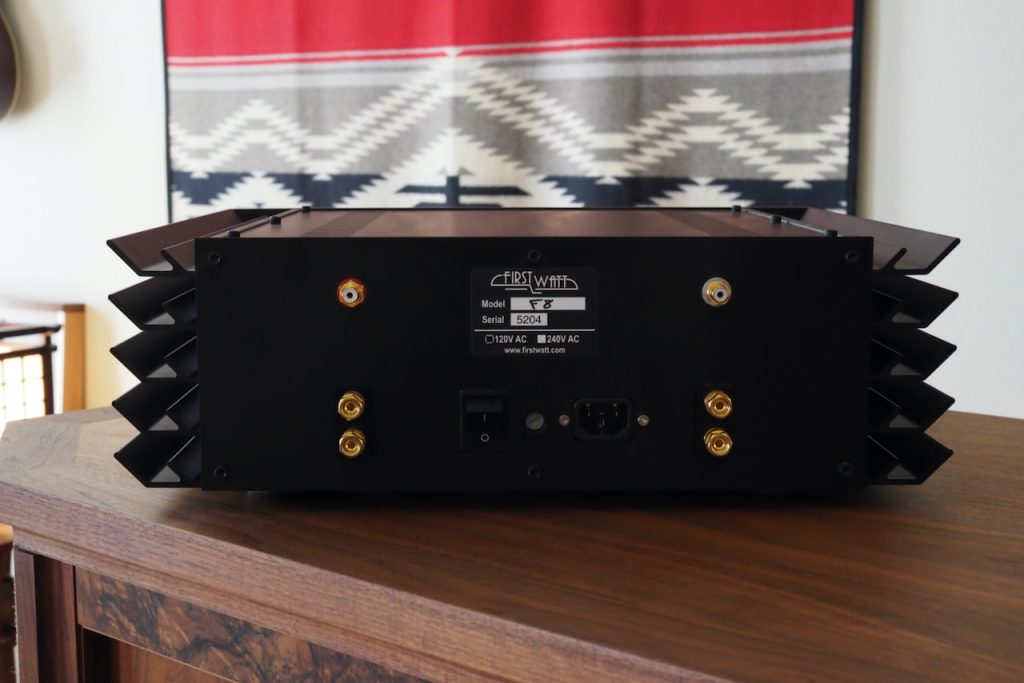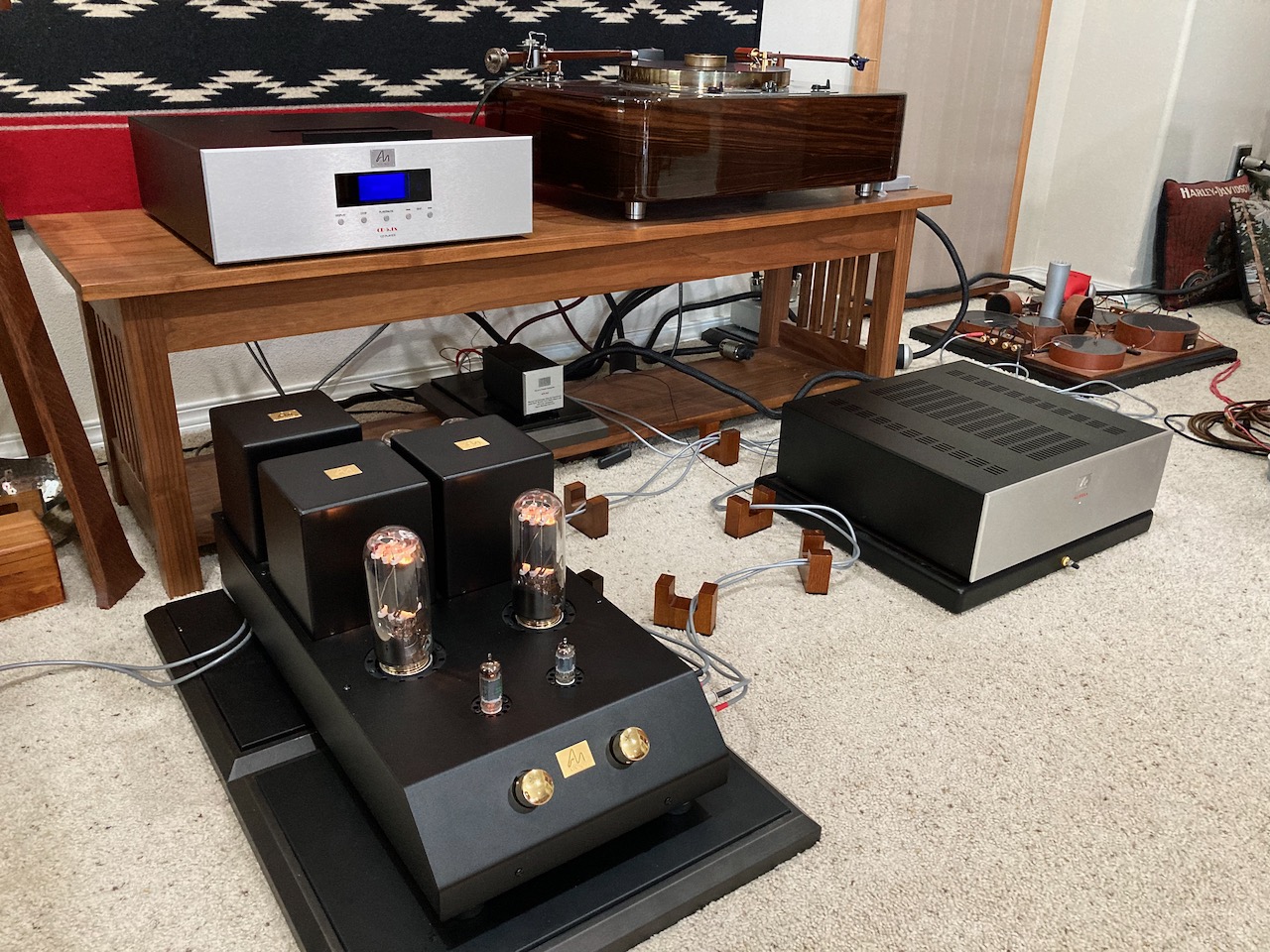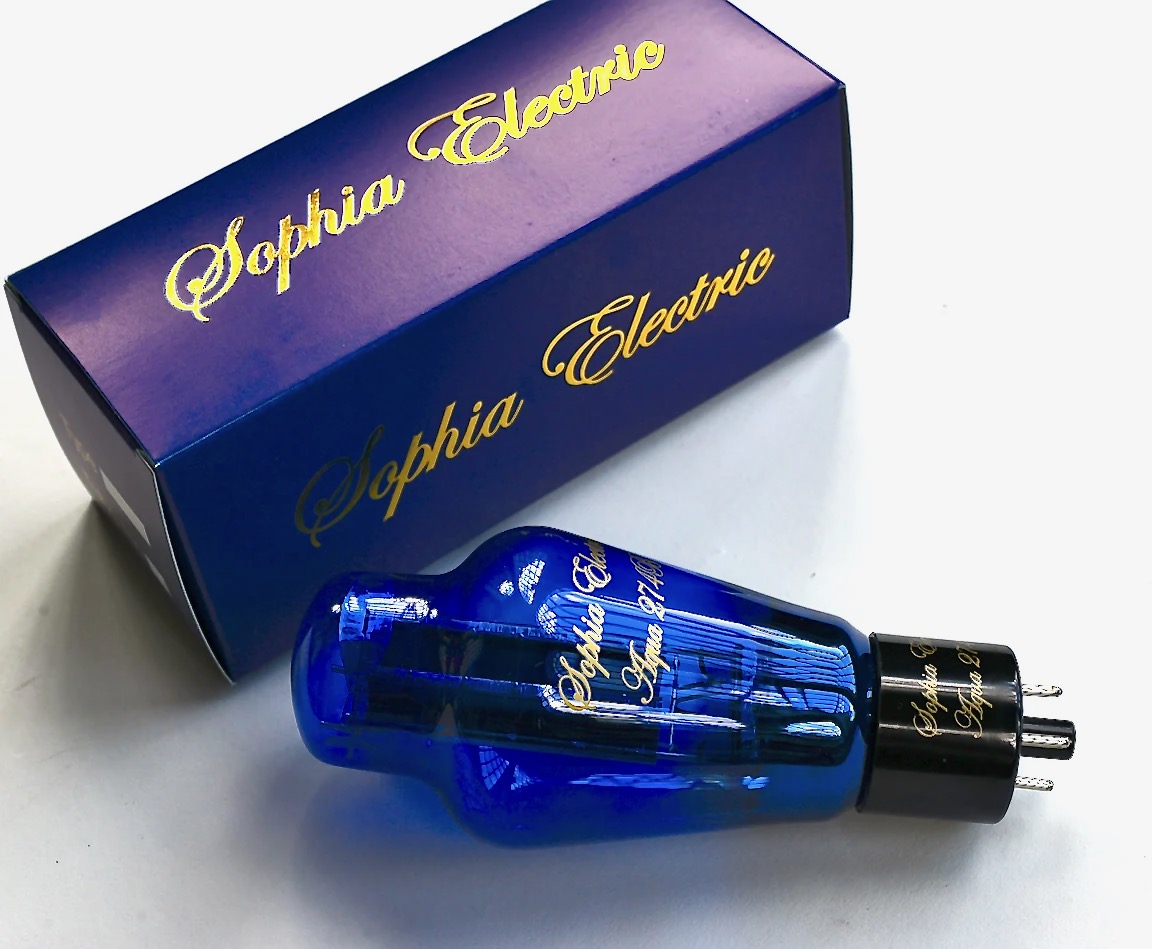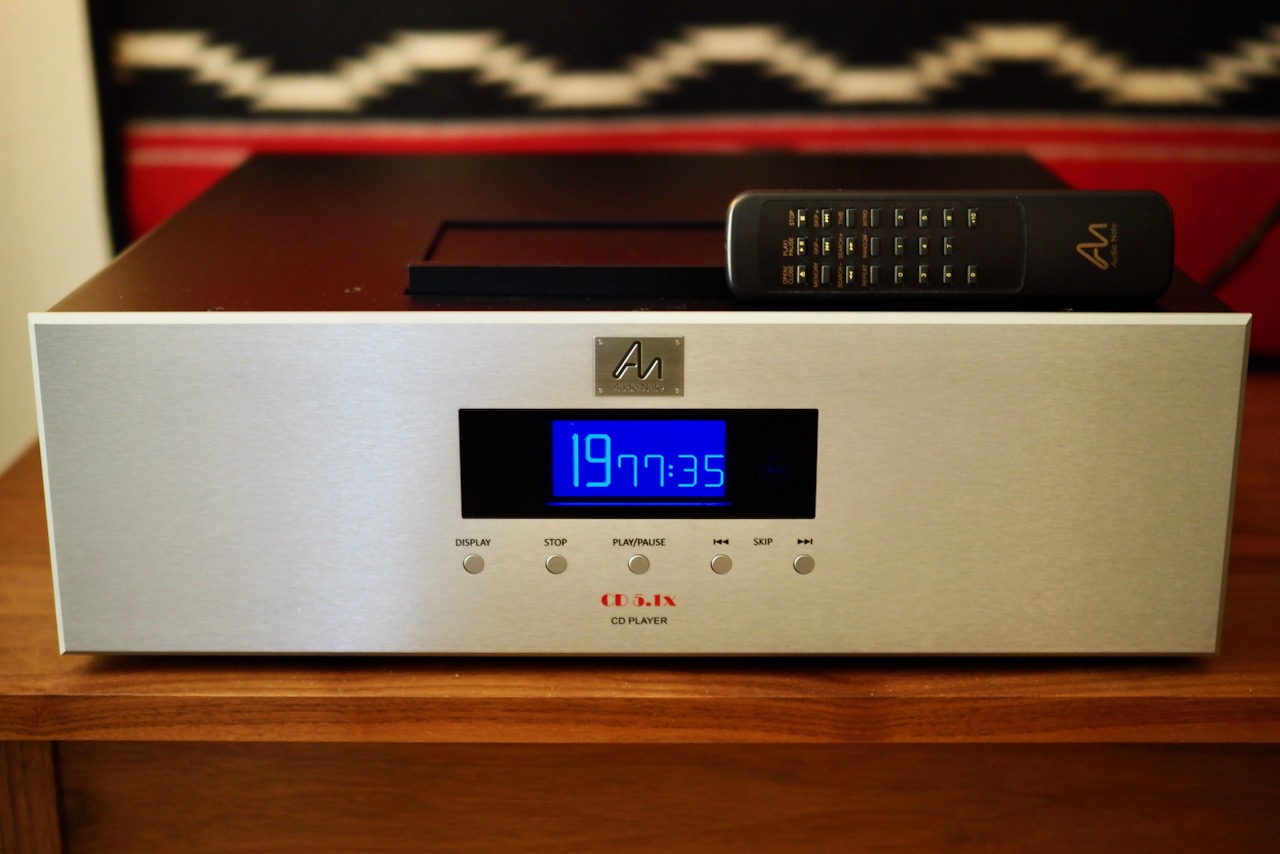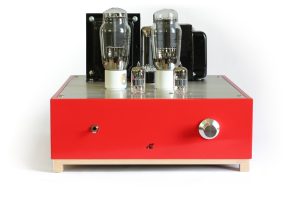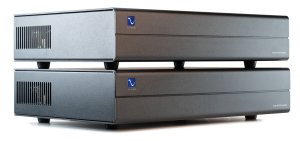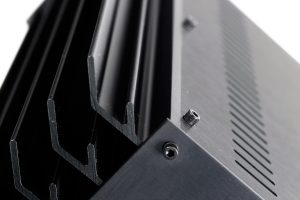Whether musing about the greater understanding the Belle II particle physics experiment at KEK may bring to questions around Standard Model predictions, dark matter, and the asymmetry of matter and antimatter in the universe, or the exciting themes of parallel universes, the multiverse, and time travel that we see imaginatively explored in science fiction, physics remains an enduringly illuminating field of study for opening up one's mind to the unseen possibilities of our phenomenal world.
That also aligns well with my own experience with the physicists I have known or worked with over the years, as they have proved to be a highly intelligent, imaginative, and creative group on many levels.
Take Nelson Pass as an example. Nelson studied physics at UC Davis, earning a Bachelor of Science in physics in 1974.
I asked Nelson if he would tell us a little about how that intersection of physics and his creative interests in audio influenced the direction of his life.

"USSR stamp depicting Sputnik 1 orbiting the Earth, the Earth orbiting the Sun and the Sun orbiting the centre of the Milky Way galaxy." Public domain image courtesy of Wikipedia.
"When I was very young the Soviets had launched Sputnik and the government became interested in finding and developing "young scientific talent", and as I had scored highly on IQ tests I was the focus of some attention. Throughout my education it was assumed that I would be a mathematician or physicist."
"But halfway through my time at Davis I decided I liked playing with audio equipment more and I began building speakers and amplifiers. I ended up at ESS just before the "Heil years", learning physics and math by day and doing speaker development by night (I met my wife Jill there—she was assembling Heil diaphragms). Amplifier design beckoned, and I left ESS to form Threshold, and later Pass Labs and First Watt."

Photograph by David W. Robinson, copyright (c) 2018, all rights reserved.
"So here I am 50 years later, happily building amplifiers and the occasional loudspeaker, devoted to electronic design as art. I look for performance in simplicity and elegance, making subtle choices of topologies and components. I think it's worked out quite well."
I think Nelson's 'physics by day, audio research by night' lifestyle during his formative years as an audio designer is a fascinating story.
That same sort of intelligence and imaginative creativity that has brought us KEK and CERN from physicists, brought us Threshold, Pass Labs, and First Watt, courtesy of Nelson Pass' devotion "to electronic design as art."
While the physicists at KEK and CERN continue to probe the boundaries of what is known and possible about the phenomenal world as it relates to particle physics, it is Nelson's enduring physics-enabled creative research into the audio arts that has brought us music and audio enthusiasts a form of transcendental illumination that helps bridge the gap between phenomenon and noumenon in the world of music and the recording arts that document it.
The intelligence and creativity that Nelson has applied to the audio arts over the years means that each new design from Nelson is greeted with a level of enthusiasm only rarely seen for other audio products, as enthusiasts know each new First Watt amplifier will be at the cutting-edge of solid-state design creativity, will sound fantastic, will be ultra-reliable, and will be affordable.
Certainly, I was very enthusiastic for all those same reasons when I heard that I was going to be able to write about the new First Watt F8 amplifier for you here at Positive Feedback.
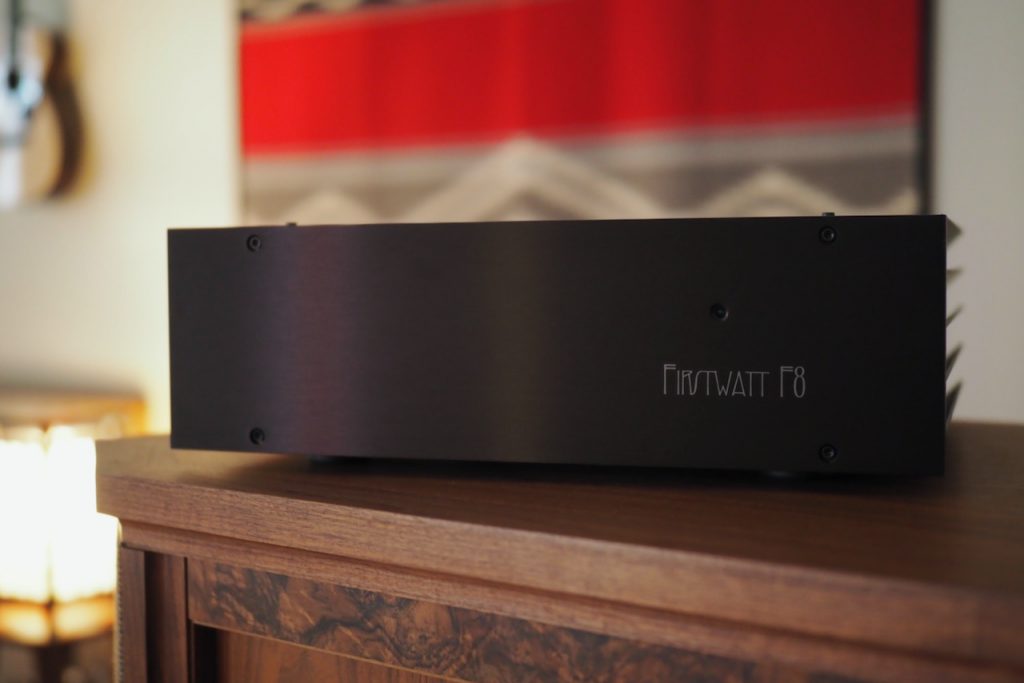
The new First Watt F8 stereo amplifier from Nelson Pass. $4000 USD.
I've been a fan of Nelson's design prowess ever since I bought a Pass Labs Aleph 3 back in 1997 (photo below).

Aleph 3 photograph courtesy of Nelson Pass.
I thought the Aleph 3 was an awesome looking amplifier. Bristling with cooling fins on all four sides, the Aleph 3 looked like it meant business.
Nelson was inspired by the sound quality and musicality of single-ended-triode vacuum tube amplifiers, and creatively incorporated analogs of those design principles into the Aleph 3, which represented a revolutionary step forward in solid-state amplifier design with its single-ended topology with only two gain stages.
Not only did the Aleph 3 have winning good looks and a ground-breaking new singled-ended solid-state amplifier design, it also sounded great and possessed superb musicality, while being affordable enough to be accessible to us working class blokes at $2300 USD (about $3983 USD in today's inflation corrected dollars).
One thing you can count on from Nelson Pass is the ingenuity and creativity of his designs, which always have a canny balance of high-fidelity sound quality and musicality that brings recorded musical performances forth with a compelling vision of live-likeness, so whenever Nelson releases a new amplifier its a big deal for yours truly.
With that, I enter into the world of the First Watt F8 stereo amplifier.
The First Watt F8 Stereo Amplifier ($4000 USD)
Like my Aleph 3 of yesteryear, Nelson's First Watt F8 is a low-powered two-stage single-ended Class A stereo amplifier, and is offered in that same spirit of affordable excellence at $4000 USD, which is within a few dollars of being the same price in inflation corrected dollars that I paid for my Aleph 3 back in 1997.

The new First Watt F8 stereo amplifier from Nelson Pass.
The 25 watt per channel First Watt F8 isn't related design-wise to the Aleph 3, however, but rather the F8 is an evolutionary descendant of the 25 watt per channel First Watt J2 amplifier, which has been the most enduringly popular First Watt amplifier ever offered by Nelson.
The First Watt J2 amplifier utilizes signal JFETs for the input stage, and power JFETs for the output stage, about which Nelson says:
"JFET transistors have long been recognized as having the highest audio quality of any transistor; the input devices of the J2 are known through the industry as the standard for low noise and linearity, and are found on the inputs of the finest phono stages, line level preamplifiers, and power amplifiers."
The power JFETs in the First Watt J2's single-ended Class A output stage use "about half the feedback of a comparable MOSFET circuit but with half the distortion and twice the bandwidth," so that's quite an advancement over a MOSFET circuit like that of my old Aleph 3.
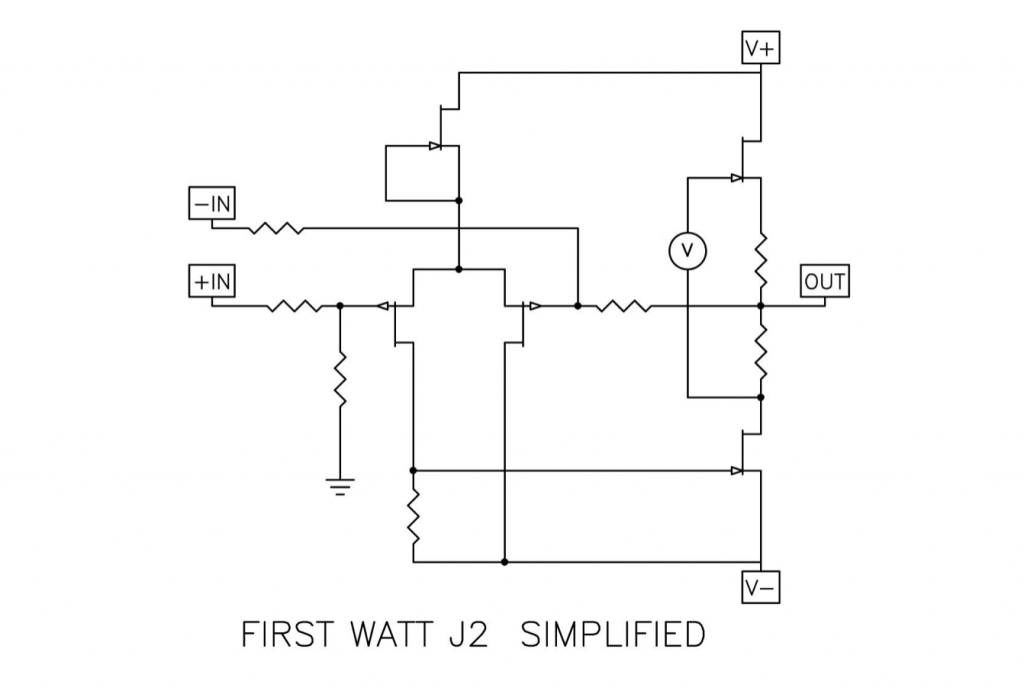
J2 circuit image courtesy of Nelson Pass.
About the J2, Nelson said, "The J2 power amplifier is simple, clean, and measures astonishingly well. It achieves a sound which is warm and relaxed, combining precision and detail without sterility. With a pair of sensibly efficient loudspeakers, it will give you a toe-tapping experience that other solid state amplifiers do not. The design is extremely reliable and will never need adjustment."
Nelson's inspiration for the F8 was that he wanted to design an amplifier with the same SemiSouth SiC R100 power JFETs used in the output stage of the J2, but with an improved input circuit.
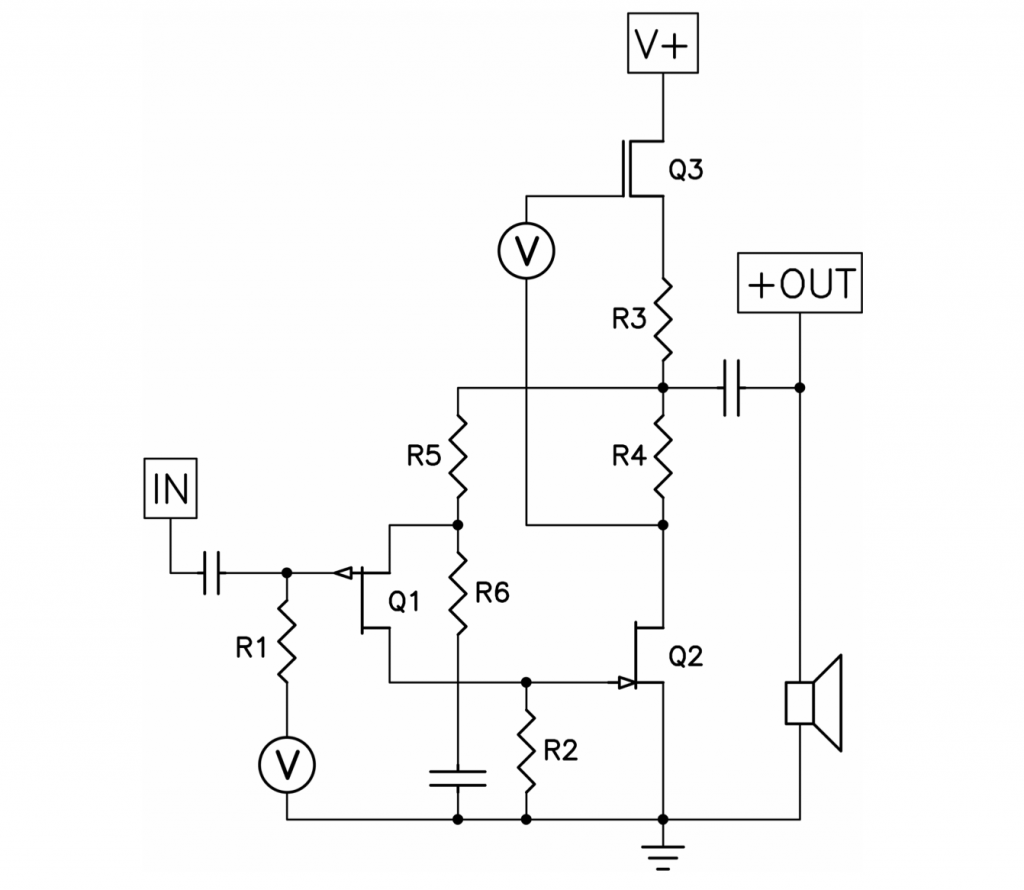
F8 circuit image courtesy of Nelson Pass.
The output stage of the F8 is the same as that of the J2, but where the J2 uses 6 JFETs in the input circuit, the F8 uses a single Toshiba 2SJ74 P channel JFET.
Nelson on the new input circuit:
"Five fewer transistors is part of the difference—the J2 input topology is what we refer to as a VFA, or 'voltage feedback amplifier'. The F8 would be referred to as a CFA, or 'current feedback amplifier'."
"Both approaches to feedback have their advantages, and there are adherents for both. In this case, the CFA topology gives several advantages—simpler circuit, simpler/smoother transfer characteristic and a little better performance by measurement."
"As you compare the J2 and the F8, you will find quite a bit of similarity, but the F8 is a modest improvement in several areas. In particular, the damping factor and high frequency response are twice as good, and distortion numbers are lower. I am pleased to note that this is achieved with 10 dB less open loop gain on the circuit and 5dB less feedback."
"Still, this is not the primary thing—it's just what I can show you in print. The real merit to the amplifier is in the experience of listening. This is a matter of how compatible it is with the rest of the audio system and the taste of the listener."
"You will have noticed, I enjoy amplifiers with a little personality. They don't have to measure perfectly, they just have to sound good. This is a simple little Class A amplifier with a very nice personality, and I hope you like it."

A quick perusal of the First Watt F8 stereo amplifier reveals a rather demure appearance that largely disappears into a late-night listening room. It's as if the F8 is saying, "It is not my looks, but the music I make, that will inspire you."
From the front, you'll see a softly illuminated blue indicator light when the amplifier is powered up. On each side are finned heatsinks that dissipate the circuits' heat.

Around back you see two pairs of binding posts, a pair of RCA inputs, a fuse holder, an IEC connector to plug a power cord into, and a power switch.
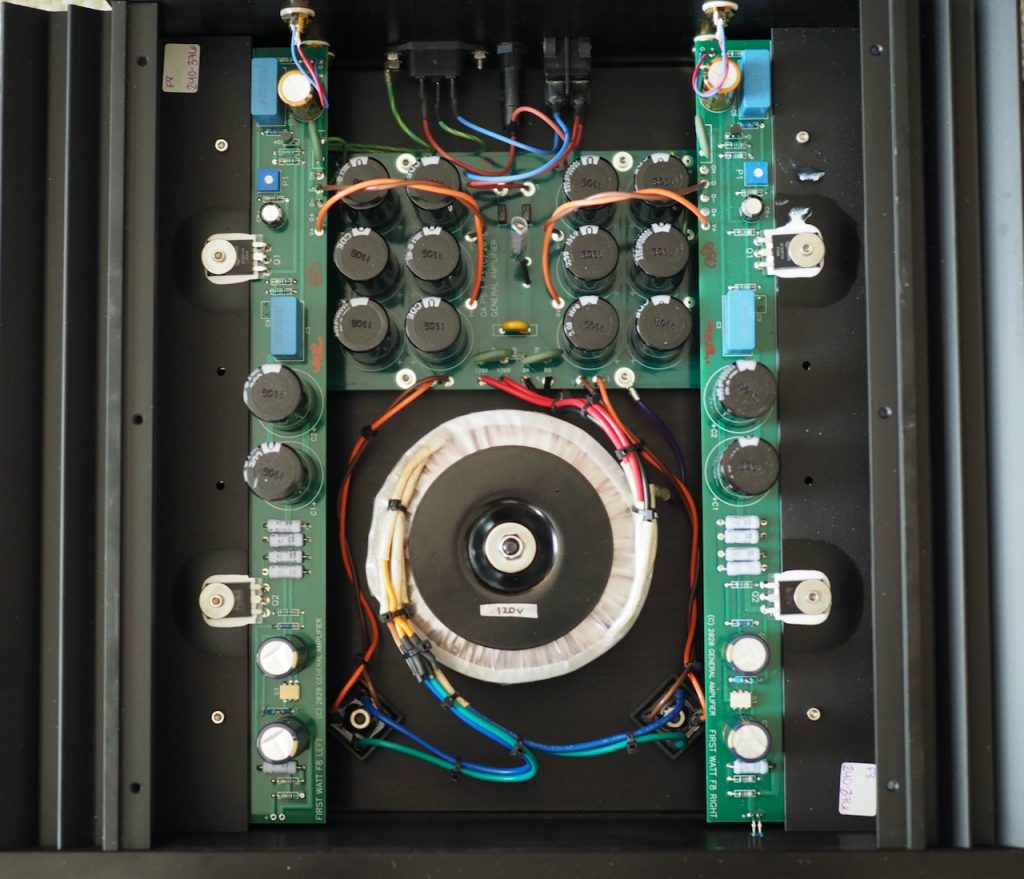
On the bottom are elastomer footers, but its when you remove the top-plate that you see where the electronic wizardry takes place.
Associated Equipment
Nelson's description of First Watt's target listeners is, "If you have efficient loudspeakers, listen at reasonable levels and are obsessed about subjective performance, then you probably have come to the right place. If you want reliable audio product, then you really have come to the right place."
Nelson's First Watt target listeners sound a lot like a description of me. My Tannoy Westminster Royal Special Edition loudspeakers are rated by Tannoy at a highish 99dB sensitivity. I confess that I am rather obsessed with subjective performance, as I want my amplifiers to have the 'sound of music' in their circuitry that makes listening to recorded performances of music fun and illuminating. I also appreciate the fact that Nelson offers amplifiers with bleeding-edge performance, that are also affordable, and completely reliable.
Probably the only area I diverge from Nelson's target listeners is that I sometimes like to listen at 'unreasonable' levels. Can the 25 watt First Watt F8 deliver live-like levels from my loudspeakers? Yes it can.
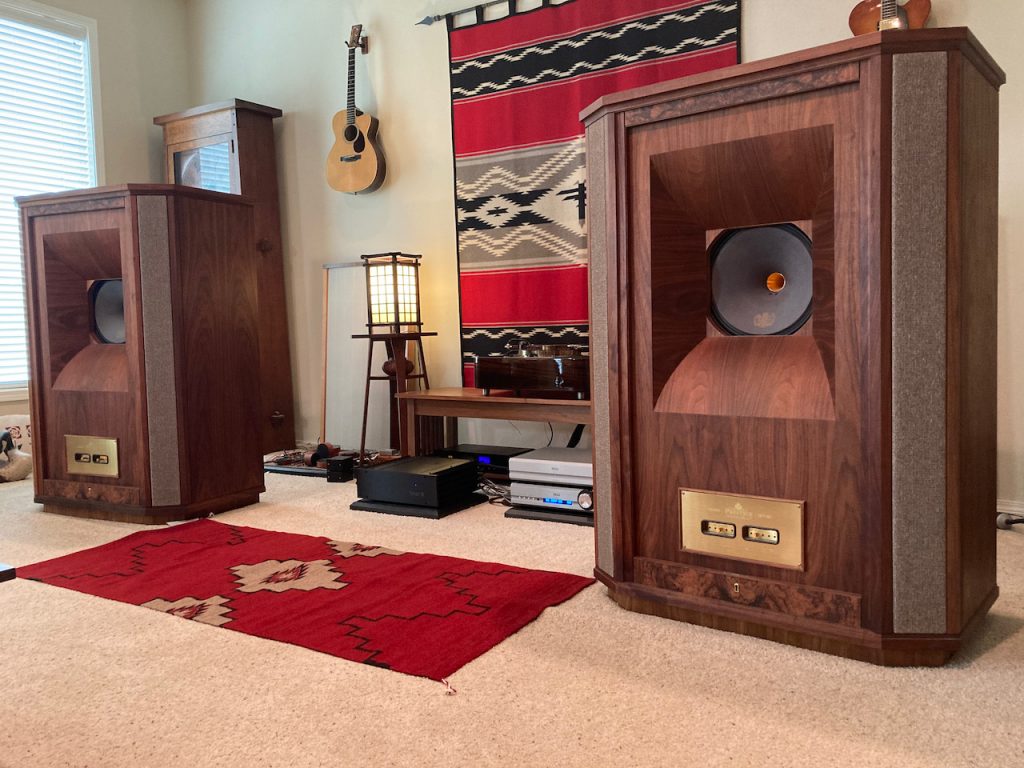
Nelson employs 15-inch Tannoy Dual Concentric drivers in custom cabinets as part of his design process for amplifiers, which you can see in the photo below.
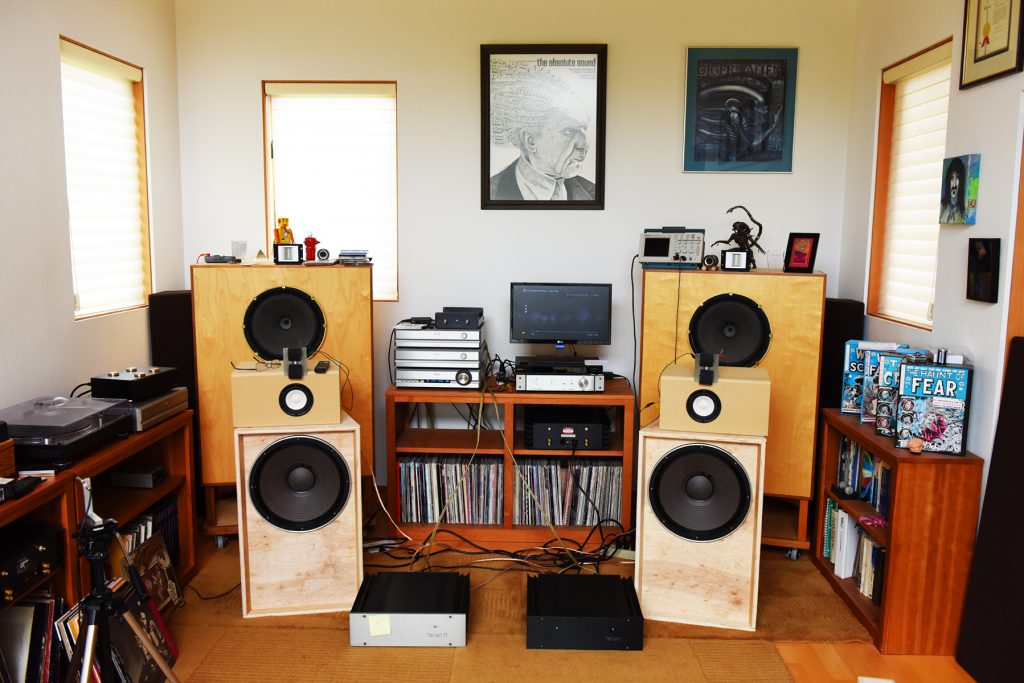
Nelson's home listening room. Photograph by David W. Robinson, copyright (c) 2018, all rights reserved.
I can tell you from first-hand experience with past and present First Watt and Pass Labs components, that they are an extremely good match to my Tannoy loudspeakers. Fellow Tannoy owners should take note.
My Westminster Royal SE loudspeakers stock crossovers have been replaced with custom crossovers consisting of Duelund CAST components, with pure silver Duelund CAST components in the high-frequency circuit, which provide a remarkably deep glimpse into the performance of upstream components (more HERE).
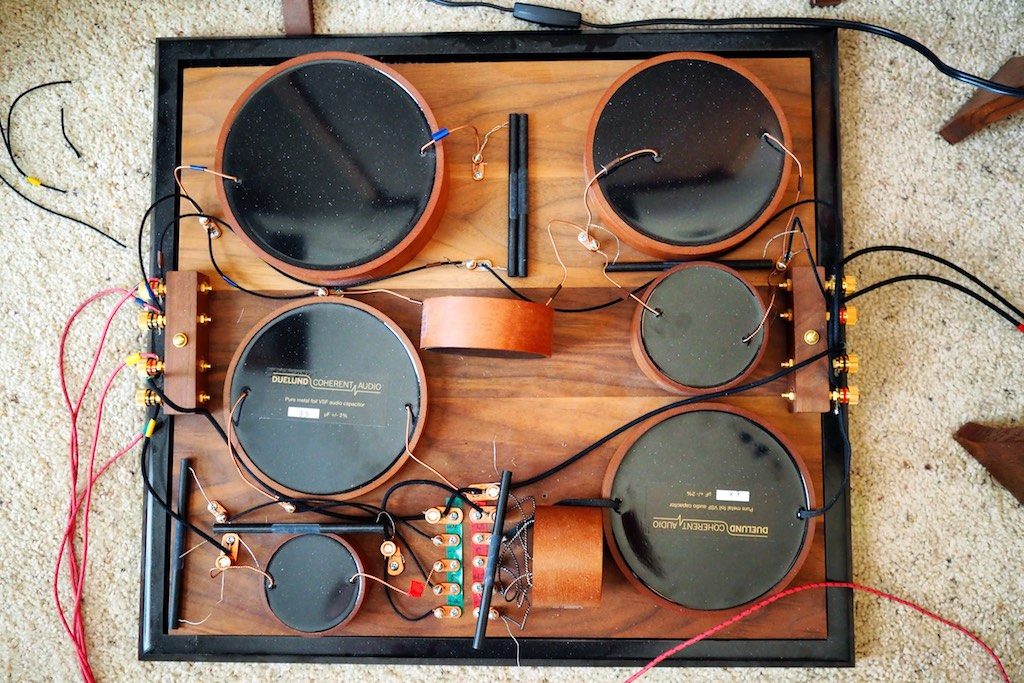
Duelund CAST crossover for a Tannoy Westminster loudspeaker.
I used Duelund DCA16GA tinned-copper speaker cables to connect the First Watt F8 stereo amplifier to my Westminsters.
The Pass Labs XP-12 line-level preamplifier (more HERE) and XP-17 phono preamplifier (more HERE) performed the preamplification duties.
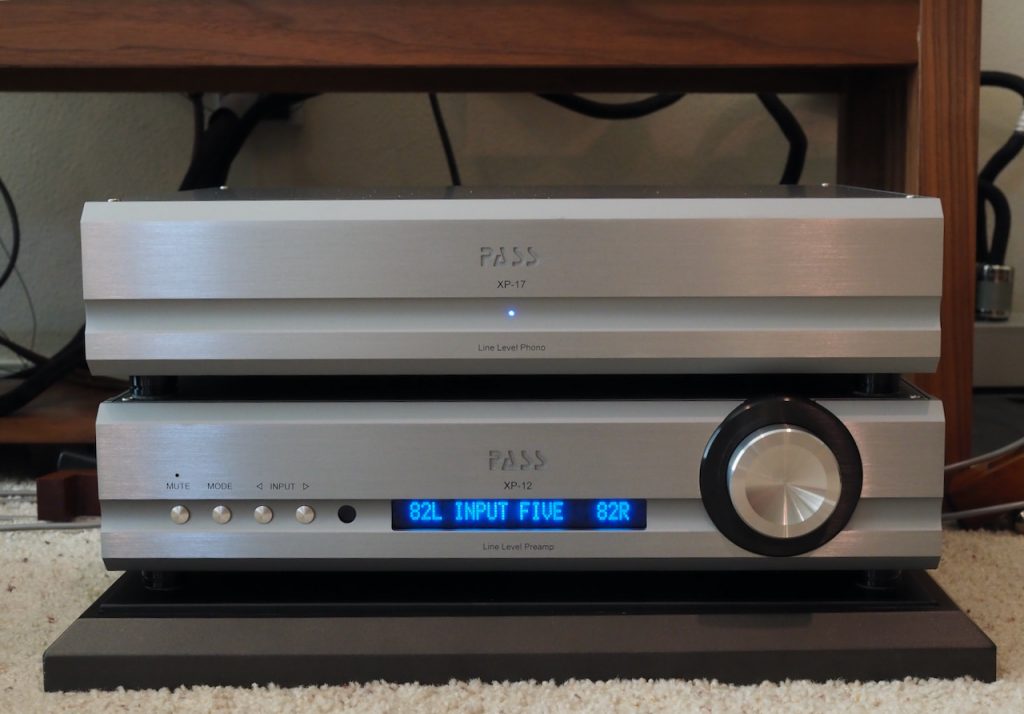
The analog source was my hot-rodded CTC Garrard 301 turntable fitted with an Audio Note (UK) Io I moving coil phonograph cartridge (more HERE).

The Audio Note (UK) CD 2.1x/II 'Level Two' Red Book CD player was used for a digital source (more HERE).

Interconnects were a combination of Duelund 'Dual' DCA16GA tinned-copper (for the CD 2.1) and Belden 8402 tinned-copper microphone cable interconnects (for the XP-12 and XP-17).
The power cables were a combination of Sablon Audio 'Robusto' (for the CD 2.1), Acoustic Revive 'Absolute' (for the XP-12 and XP-17), and an Acoustic Revive 'Power Reference' (for the First Watt F8).
All the power cables were plugged into an Acoustic Revive RPT-6 Absolute NCF Power Distributor, and an Acoustic Revive 'Absolute' power cable connected the RPT-6 to my wall outlet, which consists of an Acoustic Revive CB-1DB receptacle base plate, CFRP-1F carbon fiber outlet plate, and a Acoustic Revive modified Oyaide R-1 receptacle.
The Pass Labs XP-12 & XP-17, and the First Watt F8, were seated upon Acoustic Revive RST-38 isolation platforms.
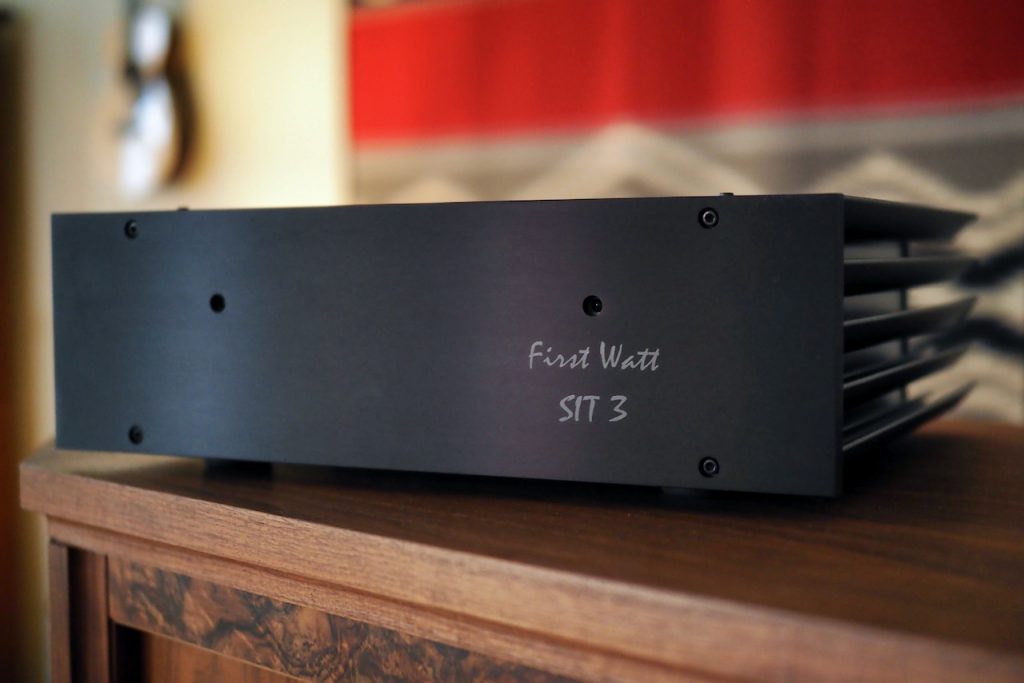
Additionally, I'll offer brief comparisons of the 25 watt per channel First Watt F8 to the 18 watt per channel First Watt SIT-3 stereo amplifier (photo above, review HERE), and the 25 watt per channel Pass Labs X25 stereo amplifier (photo below, review HERE), to give you an idea of how these three high-performance low-powered amplifiers compare.
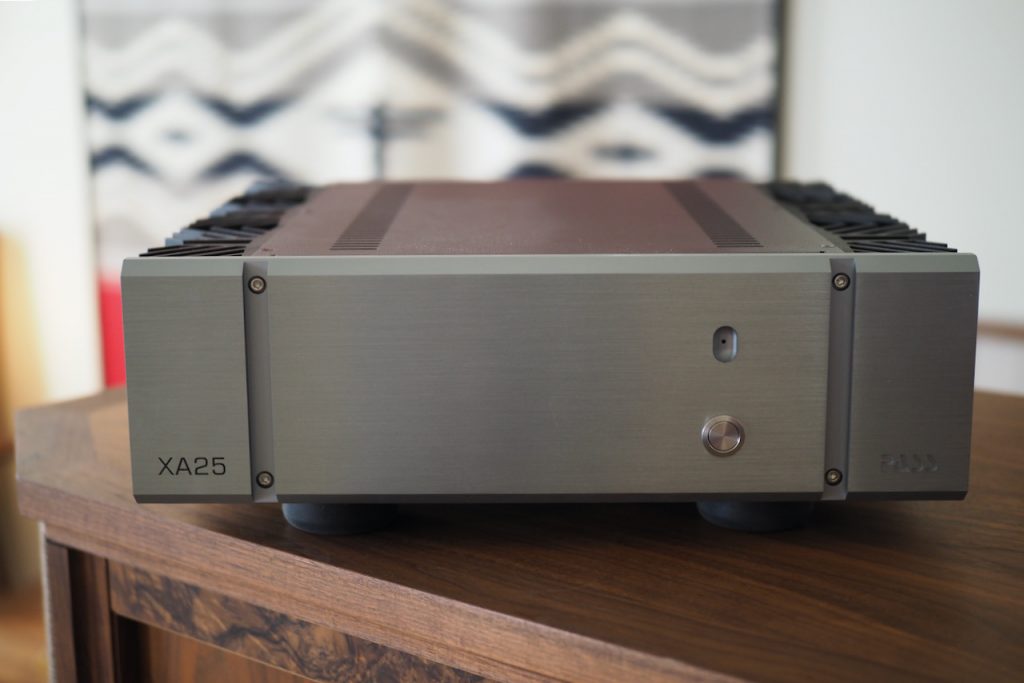
Listening Impressions
Shall we do a little physics inspired time-travel style of listening? Yes, indeed!
I have been having a lot of fun lately listening to early musical performances from the acoustic (1877–1925) and electrical (1925-1945) eras of the recording arts, in addition to my usual listening to musical performances from the magnetic (1945-1975) and digital (1975 to present) eras of the recording arts.
It turns out that quite a few of the most important musical performances ever recorded are not from the magnetic and digital eras of recording that we audiophiles typically listen to, but are from the early acoustic and electrical periods of the recording arts.
A pertinent example of important musical performances from this period can be seen in Rob Cowan's article in Gramophone, 250 Greatest Recordings of All Time: Chosen by 35 of the World's Leading Musicians (HERE).
The focus of Rob's list of recordings is on the quality of the musical performances, as chosen by leading musicians, rather than on the recording quality of the albums per se, which is often the focus of audiophile listening sessions.
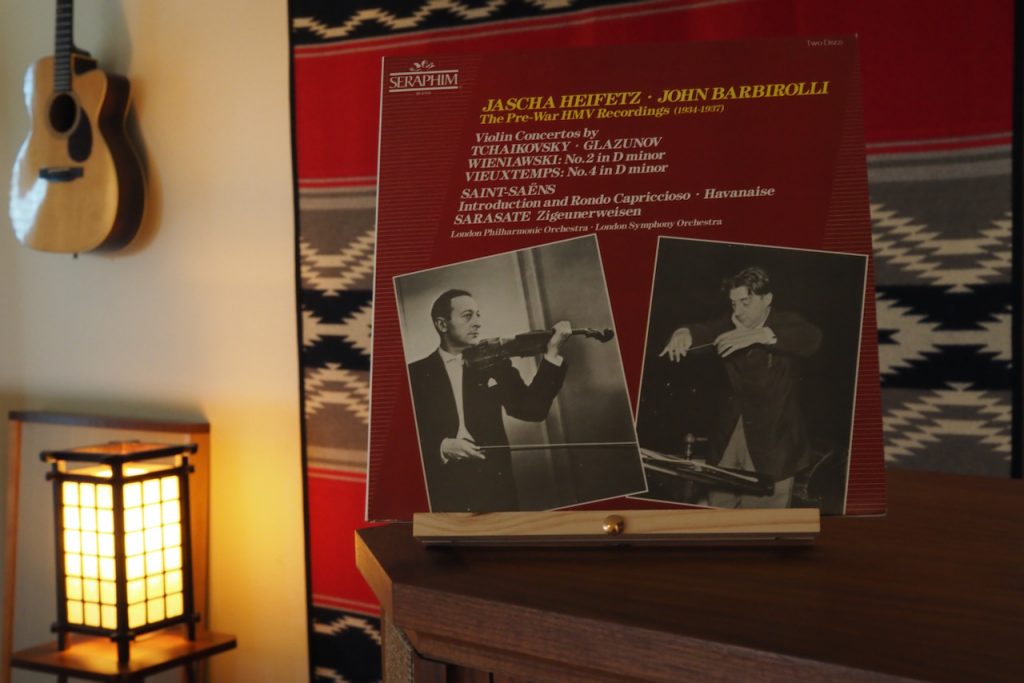
The superb musical performances of Saint-Saëns and Sarasate by Heifetz-Barbirolli that violinist Hilary Hahn chose for Rob's article in Gramophone are a perfect example.
Those performances were originally released on 78 records, which were recorded 1935-1937 by EMI during the electric recording era (1925-1945), and then were made available again in 1987 as the Heifetz-Barbirolli The Pre-War HMV Recordings 2 LP album set, due to their enduring importance as great performances (photo above).
The recording quality can actually be quite good from the early recording eras, although the recordings are typically noisier (but not always), and tend to have less recorded information above 6,000 Hz (but not always), than we find in the magnetic recording era, for example.
Many of those early performances were recorded direct-to-disc at 78 rpm, so you know there's a lot of good musical information stored in those grooves.
Interestingly, some of those early recordings have higher-fidelity within the bounds of their recording limitations of noise and frequency extension than do many recordings of later recording eras.
As I have been listening to recorded musical performances that span the entirety of the eras of the recording arts, it has been impressed upon me how important it is to have an audio system that can provide a high-fidelity listening experience that spans the four recording eras, rather than just from those few albums of exceptional recording quality from the magnetic and digital recording eras that we audiophiles typically listen to.
I have found that if I optimize my audio system voicing for maximum sound quality, using only audiophile-style albums, that my audio system will sound dreadful on the majority of albums from our historic recorded music canon, greatly limiting the music that I can enjoyably listen to.
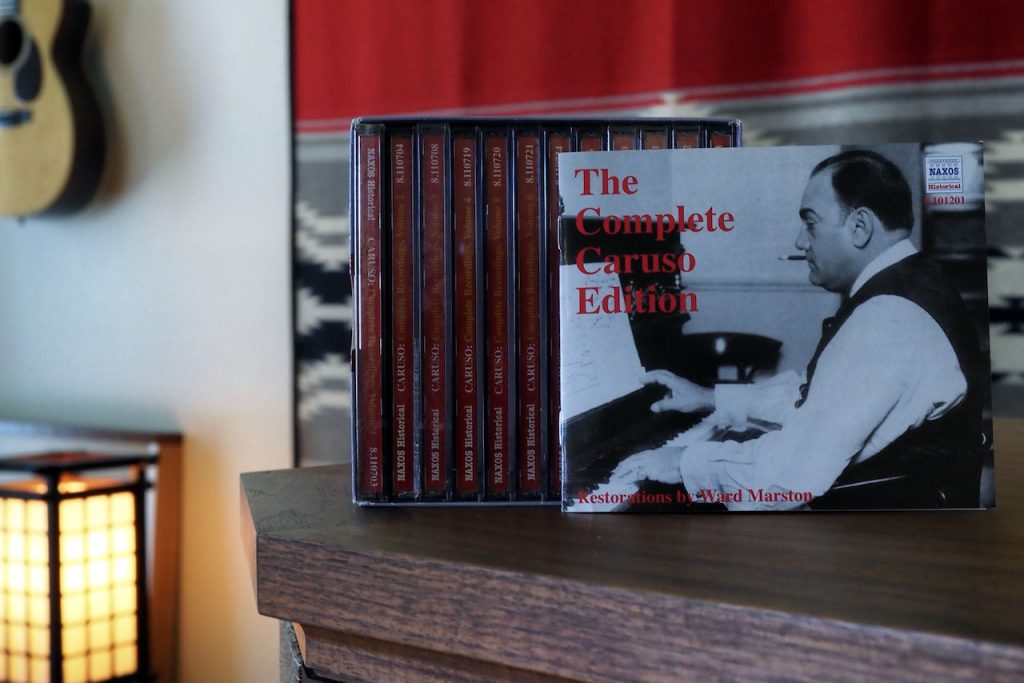
However, when I optimize my audio system to provide high-fidelity listening experiences from albums that span the entirety of our historic recorded music canon, my audio system also provides amazing listening experiences from that small subset of audiophile-approved albums. That's a win-win.
Here's what I've also found out. If I listen to albums from the acoustic and electric eras of recording and they 'sound bad', its not actually the recordings that sound bad, but rather its the audio system voicing that needs adjusting.
When the system voicing is off, those early recordings can provide an opportunity to adjust the voicing of my audio system so that it is capable of providing high-fidelity listening experiences from all of the recording eras of our recorded music canon, which opens up new worlds of listening adventures for me.
For example, albums like Enrico Caruso: The Complete Recordings (recorded 1902 to 1920 during the acoustic era), Duke Ellington 1927-1934 (recorded during the electrical era), Miron Poliakin Plays Glazunov, Tchaikovsky, Beethoven, Schubert, and Sarasate (recorded 1938-1939 during the electrical era) are all absolutely amazing on a high-fidelity audio system, if the audio system's voicing is up to it.

I was musing upon these aspects of music listening and audio performance as I started writing this article about Nelson's new First Watt F8 stereo amplifier.
As I listened to some great musical performances from our recorded music canon that spanned the four recording eras, it occurred to me that instead of pronouncing the F8's name as "F" "8", it might be best pronounced as "Fate," which more closely articulates how exceptionally well it provided high-fidelity listening experiences across the diverse recordings of our recorded music canon.
Not only did the First Watt F8 imbue impressive high-fidelity listening experiences to musical performances from all of the recording eras, it also provided fascinating insights into the recording techniques used in the different eras, lending a sort of auditory authenticity to the recordings that was truly illuminating, and made listening sessions feel almost like time travel experiences.
I'll share some listening impressions with you from a typical listening sessions of late, where I listened to recordings that spanned the acoustic, electrical, magnetic, and digital eras of the recording arts.
Most of us don't have a dedicated audio system for playing 78 records, but fortunately for us there are a number of record labels and individuals who are passionate about preserving recordings of great musical performances from the early recording eras, and offer transfers from those 78 records to CDs, so the rest of us can hear how remarkable those early performances and recordings were (more HERE).
I can't overemphasize how important these early recordings are to our recorded music canon. One of my favorite quotes on the topic was made by Bruce Burroughs, Music Critic & Editor of The Opera Quarterly, in the Winter 1991/1992 issue:
"It is increasingly the case, and very sadly so, that new recordings of the landmark masterpieces of the standard operatic repertory can be satisfying on any deep level only to those with the least experience and the shortest memories … We don't go to the recordings of Caruso or Melchior, Ponselle or Flagstad for the sonics. We go because we want the real thing—the vocal capacity and dramatic ardor that cannot be dimmed by mere matters of sound reproduction. The voices fairly jump out at us from whatever dim and unsatisfactory technology enshrines them."
Nelson's latest record player acquisition! Photo by Nelson Pass.
I should mention that after reading the 'sneak peek' of this article at Jeff's Place, that Nelson sent me a photo of his latest record player acquisition (above).
That's right, there's quite a number of us that enjoy listening to 78s, whether on a vintage gramophone like Nelson's, or as transfers from 78 records to CDs. There's a lot of fun to be had, and you can read more about it HERE.
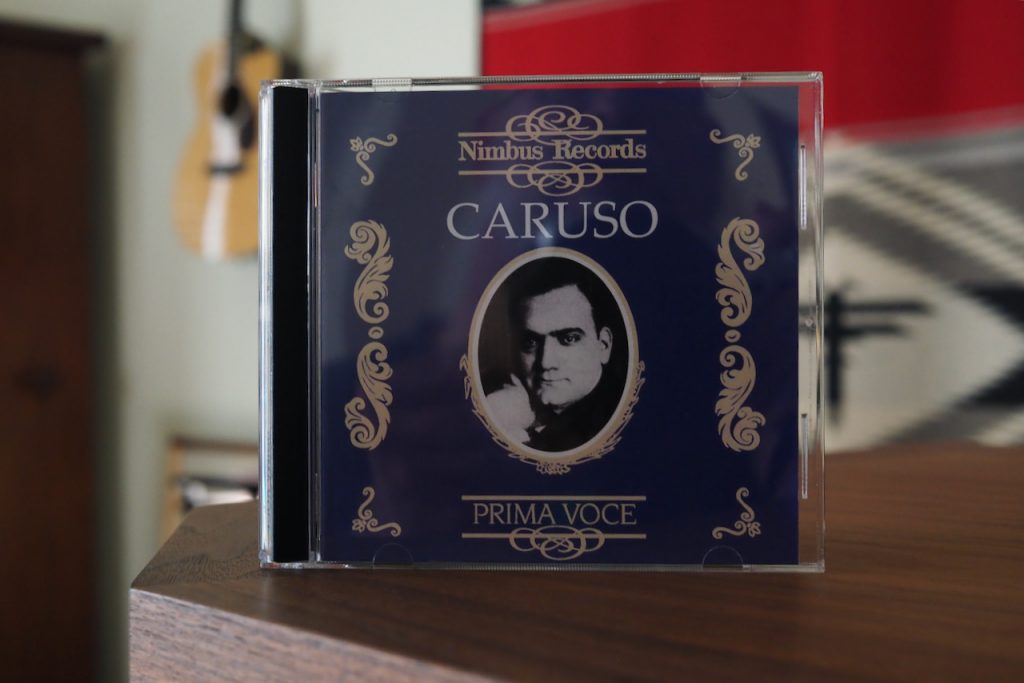
The Acoustic Era of Recording (1877-1925)
Let's start our time travel adventure with an example of recorded performances of Enrico Caruso from the acoustic era of recording (1877-1925), the Enrico Caruso in Opera Volume 1 1904-1920 CD, that is part of the Nimbus Records 'Prima Voce' series of albums offered by the Wyastone Estate in the UK.
Enrico Caruso (1873-1921) was one of the great Italian operatic tenors, and was a prolific performer, making abundant appearances in the opera houses of Europe and the Americas during his 25 year career. Case in point: Caruso performed an astonishing 863 times at the New York Metropolitan Opera alone during his career!
Fortunately for music lovers, Caruso was also an early adopter of the recording arts, and released 247 albums as 78 records during his career, and perhaps could be considered the recording arts first superstar.
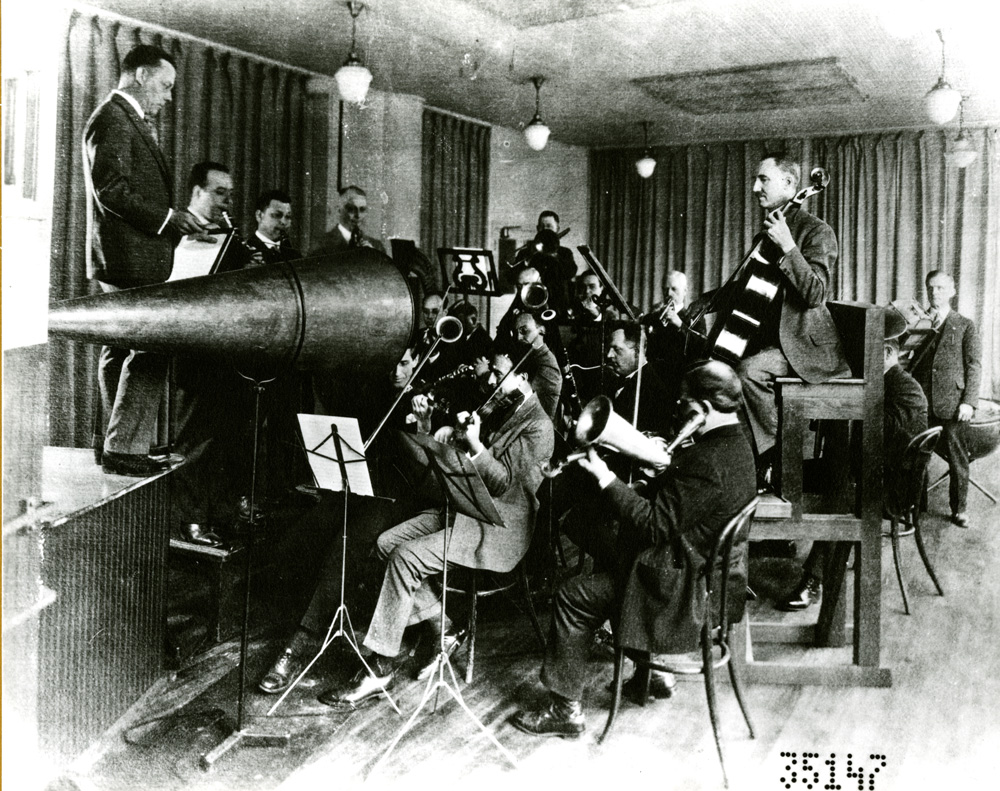
Early acoustic recording session. Photo courtesy of the US Library of Congress.
The recording equipment was mechanical during the acoustic era of recording, and the musicians were positioned in front of a 'recording horn', and then sang and played their instruments into the horn (photo above).
The music entering the horn was focused down to the small end of the horn, where it vibrated a diaphragm with an attached stylus, that etched the sound waves into the recording medium. The recording master was then electroplated to create a stamper, from which the record albums were made.
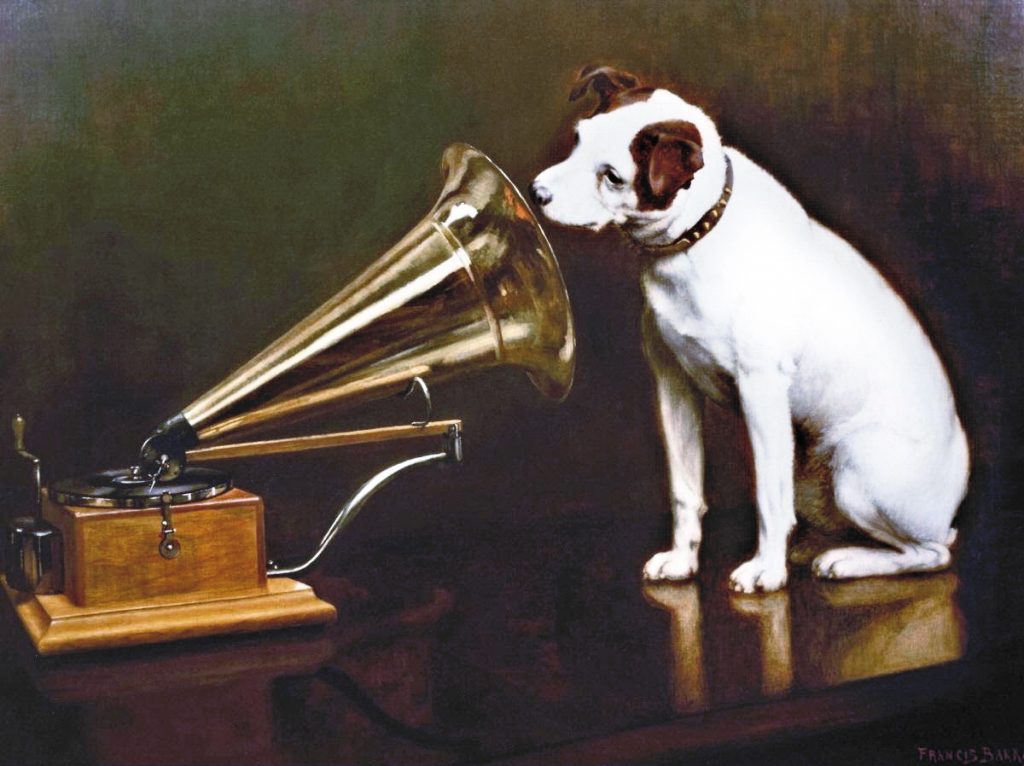
Public domain photo courtesy of Wikipedia.
Playback was also mechanical, by means of a gramophone, which essentially used the reverse of the recording process to play back the recorded performance through a horn.
The frequency extremes are missing from those early recordings, and sometimes they can have a bit of surface noise, but those direct-to-disc live recordings are rather amazing to hear on a high-fidelity audio system of today.
The performances of Enrico Caruso in Opera Volume 1 1904-1920 were transferred from 78 records using Nimbus Records' unique method of playback over the 'Prima Voce' horn, and re-recording them from the horn's output, which you can learn more about HERE.
Photo courtesy of Nimbus Records and the Wyastone Estate.
With the First Watt F8 providing the amplification, Caruso was absolutely amazing to listen to over my big Westminster Royal SE loudspeakers. Caruso's incredible voice transcended the acoustic era recording technology to fill my room with impressive vocal performances.
The First Watt F8 revealed the surface noise to be minimal on these Nimbus Record transfers of Caruso's performances, and I found the dynamics to be rather remarkable by any measure. I also heard an expansive 'acoustic' spaciousness from the recordings in my room, courtesy of the F8, and while the performances had the sound signature of recordings from antiquity, I found that to be endearing rather than distracting, and I enjoyed every moment of my listening to these important performances by Caruso from the acoustic era of recording.
Perhaps most importantly, the First Watt F8 allowed the full emotional connection to the music to come through powerfully, giving me frequent full-body 'goosebumps' during listening.
So what did I learn about the First Watt F8 from listening to Enrico Caruso in Opera Volume 1 1904-1920?
Well, the F8 is bloody good at providing convincing musical experiences from these ancient recordings. My listening experiences were overflowing with emotional connections to the music that are not easy to articulate. I'm not really an opera guy per se, but hearing these performances by Caruso just blew me away. They were intense. They were beautiful. They were moving. Maybe I am becoming an opera guy after all, courtesy of the F8.
The First Watt F8 sounded naturally warm, spacious, and smooth. I really enjoyed the way Nelson voiced the F8. The F8 is a musically adept amplifier, and is sure to delight the music lovers among us who want to explore the span of our historic recording eras.
From a sound quality perspective, the First Watt F8 told me a lot about these ancient recordings. While I was listening, I felt like I was hearing back through the horn into a recording venue of long ago, experiencing musical performances with a live-like intensity from times past. Listening felt like time travel, and the First Watt F8 lent an appropriate 'authenticity' to the recordings that was impressive.
'Real sound' circa 1900 during the acoustic era of recording, I loved it.
The Electrical Era of Recording (1925-1945)
Now let's jump forward to the electrical recording era (1925-1945) in our time travel listening adventure.
I've been happily listening to my Testament LP box set of the 1955 Wagner Ring cycle from the magnetic era of recording (1945-1975), with Joseph Keilberth conducting the Bayreuth Festival Orchestra, when recently I came across the Dream Ring from the Immortal Performances Recorded Music Society.
The Dream Ring was assembled by Richard Caniell, a passionate aficionado of Wagner Ring performances, who had dreamed about assembling an ultimate Ring cycle for forty years, and over the course of twenty years cherrypicked the greatest performances from the "Golden Age of Wagner" to create his own "dream" Ring cycle.
The Dream Ring features performances from the electrical era of recording that were sourced from a private collection of NBC transcription disc recordings of live broadcast performances at the Metropolitan Opera and Covent Garden in the 1930s.
The NBC transcription discs were typically 15 minutes long, so NBC recorded the discs in series, where the next disc started recording just before the preceding disc ended, until the full performance was recorded (there's about 13 hours and 15 minutes of recording for a full Ring cycle, or about 53 transcription discs).
You can read more about the history of the NBC transcription discs at the Library of Congress website HERE.
The Dream Ring was assembled using the best transcription discs from these performances, and transferred to digital with a 24-Bit Prism ADC using minimal processing (you'll want to read the extensive documentation that comes with the Dream Ring for the full story).
The Dream Ring is a magnificent production, and the First Watt F8 stereo amplifier allows all of the musical grandeur and excitement of those 1930s live broadcast performances to come through in a striking and thoroughly enjoyable fashion.
There are a few places, here and there, where the transcription discs had degraded over time, and the F8 navigates those moments in fine fashion, providing the musical essence of the unfolding performances while minimizing occasional recording issues from those ancient transcription discs.
Listening to these great Ring performances from the electrical recording era on a high-fidelity audio system is a mind-bending experience, courtesy of the F8.
The F8 clearly showed how impressive the dynamic contrasts were on those early recordings, while also giving an excellent sense of the room filling acoustic ambience encoded into them.
What is a little harder to articulate is how thrilling this music is, courtesy of the F8. The vocals vigorously leapt from the recording into my listening room, resulting in an adrenalin filled listening response from me.
Through the F8, the Dream Ring wouldn't make for casual background listening, as it demanded my full attention. I felt like I was in a constant state of suspense as I listened, on alert for what would unfold in the performances in the next moments. It was exhilarating!
So what did I learn about the First Watt F8 from listening to Richard Caniell's Dream Ring from Immortal Performances?
First and foremost, the Dream Ring illuminated for me how emotionally involving the First Watt F8 amplifier was when playing this grand music. Through the F8 the Dream Ring toyed with my emotions like they were a marionette on a string, one moment giving me goosebumps, the next I was in a state of shock and awe as the performances unfolded. The F8 was incredibly musically engaging while listening to the Dream Ring.
Secondly, I found that the First Watt F8's warmish, smooth, transparent, and resolving nature minimized the recording quirks of these ancient discs. Noise on the recordings was never a distracting issue, never got in the way of the musical performances, thanks to the canny voicing of the F8.
I think the suave way the F8 handled recording quality issues is a big deal for those of us who are adventurous listeners wanting to explore the grandeur of our entire recorded music canon. The F8 made exploration of those incredible ancient performances something I looked forward to with anticipation, and never once did recording quality issues get in the way of providing absolutely thrilling listening sessions.
From an audiophile perspective, I found it to be impressive what the F8 revealed to me about the nature of recordings during the electrical era. The 'holy trinity' of dynamics, vivid image presence, and natural tonal balance - that makes music come to life during listening sessions—was present in awe-inspiring abundance. Add to that the immense sense of acoustic ambience the F8 recovered from the recordings, which filled my living room, and the F8 was the perfect recipe for providing awe-filled listening sessions.
As a final point, the way musicality was rendered by the F8 was truly impressive. There's something organic, living, full of the breath of life, that is presented by the F8 that just makes the music sound right. Never once did I find myself thinking about how timbre, tempo, melody, etc., were portrayed by the F8. Rather, there was always an authenticity to how the music was presented from the recordings that just seemed right.
'Real sound' from the electrical recording era, circa 1930. I loved it.
The Magnetic Era of Recording (1945-1975)
For the next time travel stop in our recording era listening adventure, let's jump forward to the magnetic recording era (1945-1975).
Audiophiles typically like to spend a lot of time in the magnetic era of recording as the recording arts hit a high-point of sound quality during this period, not to mention there was a lot of great jazz, rock & roll, blues, country, and other music that emerged during this period.
It seemed fitting that for the magnetic era I should switch over to my turntable to play LP records, given LPs were an enduring commercial format throughout this recording era, and are still highly regarded by audio cognoscenti .
I used the Audio Note (UK) Io I moving coil phonograph cartridge—a stonking good cartridge—with the Pass Labs XP-17 phono equalizer. I set the XP-17 to 21.3 Ohms of resistive loading and 100pF of capacitive loading, which I thought provided a well balanced tonal and dynamic presentation across the frequency bands.
The Jim Hall Concierto album was recorded in 1975 by Rudy Van Gelder at Van Gelder Studios, and featured the all-star cast of Jim Hall (guitar), Roland Hanna (piano), Ron Carter (bass), Steve Gadd (drums), Chet Baker (trumpet), and Paul Desmond (alto sax).
Concierto is a classic 'audiophile album' for its combination of great musicians, great music, and the "transparency, warmth and presence" of its recording quality.
While held in high regard by audiophiles for the alluring "transparency, warmth and presence" of his recordings, Van Gelder was also somewhat controversial for his open distain of vinyl records and his preference for digital recordings.
Van Gelder was criticized by musicians (and other recording engineers) for changing the tone of the instruments through equalization, boosting the high-frequencies (which a lot of audiophiles tend to like), and for his use of compression.
I thought it would be interesting to hear what the First Watt F8 amplifier would tell me about Concierto compared to the Jim Hall and Red Mitchell (Artist House AH 5) album.
Jim Hall and Red Mitchell was recorded live at Sweet Basil in New York City in 1978 at 15 i.p.s on a Studer B-62 two-track recorder in the tradition of magnetic era recording, and was mastered by Bob Ludwig.
Here's a couple of interesting factoids about the Jim Hall and Red Mitchell album for you.
The first factoid is for you guitarists reading this (from the album liner notes): Jim Hall plays his "... Gibson ES-175 with fingerboard and bridge by Jimmy D'Aquisto and a single pickup by Attila Zoller. Jim uses a Gibson GA-50 amplifier."
The Gibson ES-175 was arguably the most popular jazz guitar in history, being used by jazz guitar greats such as Jim Hall and Joe Pass. The Gibson GA-50 amplifier (made between 1948 and 1954) amplifier was favored by numerous jazz guitarists for providing the ultimate 'jazz guitar tone.'
Both the ES-175 and GA-50 are no longer made by Gibson, which is a tragedy of epic proportions for jazz guitarists, and one that I hope Gibson recognizes and remedies with reissues of both.
I might add that the guitar shown in the album cover photo was a custom guitar that luthier James D'Aquisto built for Jim, and that Jim played as his main guitar from 1983 to until 2003, but its the Gibson ES-175 that Jim played on this album.
After 2003, Jim played a guitar that Roger Sadowsky built for him that was a 'replica' of the D'Aquisto, as Jim's D'Aquisto was getting too valuable to travel and tour with. For the eagle-eyed among you, the guitar hanging on the wall in the background of the above photo is also a Jim Hall / James D'Aquisto 'replica' guitar made by Roger Sadowsky.
The second factoid is for you Altec loudspeaker fans: Red plays "... a 200 year old German bass... Red's amplifier was custom made... (with) two enclosures with an 15" Altec speaker in each."
Here's a third factoid: My friend and jazz guitarist, David Gitlen, was present for the recording sessions of Jim Hall and Red Mitchell at Sweet Basil.
David told me, "Sometimes when you hear someone play live, and then you hear the album from the live performances, they don't sound the same."
Upon hearing the album played through my system David said, "That's exactly what Jim and Red sounded like during those performances."
If you want to know what Jim Hall sounded like when playing live, listen to Jim Hall and Red Mitchell.
David is not only extremely perceptive about everything the musicians are doing that are playing on the albums, but he's got superbly attuned hearing and can pick out even the subtlest variations related to recording attributes or audio equipment performance during our listening sessions.
David is a treasure to listen to music with. Not only is David a great jazz guitarist, he also studied & played with some of the greats, like Jim Hall and Joe Pass. Because David has lived the jazz guitar life that most of us only get to read and dream about, he has lots of great stories about music, jazz, and guitarists to share, and I love hearing them. I've learned so much from David.
David had a very perceptive aural observation while listening to First Watt F8 playing music. At first I didn't quite understand what David was getting at, but then I had a bit of an aha moment after reflecting upon it.
We had been listening to quite a few amplifiers during our listening sessions, the First Watt F8 stereo amplifier, the Triode Lab EVO 45 SET integrated amplifier, the Audio Note (UK) Oto Phono SE Signature integrated amplifier, etc.
David had made the comment that he preferred the First Watt F8 and Triode Lab EVO 45 to the Audio Note (UK) Oto Phono SE Signature, because he thought the Oto sounded 'distorted' in comparison to them.
Personally, I'm a huge fan of the Oto, and I didn't hear any distortion coming from it, so I was a little confused.
David isn't aHiFi guy per se, but rather a semi-retired professional musician with damn good hearing and perception for all things music and audio, so I thoughtfully considered his comment.
It finally dawned on me that what David was hearing wasn't distortion in the normal sense of that word, but rather David was hearing the difference between the singled-ended output of the F8 and EVO 45 versus the parallel single-ended output of the Oto.
There is a pristine clarity, purity, and natural musicality associated with single-ended output devices, which when compared to anything else, are usually a step above performance-wise.
The First Watt F8 was richer, warmer, and darker than the 45 EVO, but has that same sort of single-ended magic in terms of clarity, natural tone, and an overall engaging presentation of the music.
The F8 doesn't quite reach the lofty level of single-ended-triode goodness of a 45 vacuum tube, but is not that far off either, and has the added benefit of over ten times the output power of the 45 EVO, which can come in handy for less sensitive loudspeakers.
So what did the F8 tell me about Concierto and vice-versa? (my version of Concierto is from Pure Pleasure Records)
First of all, the musicality of the F8 is superb, and it made Concierto fun to listen to. The F8 also revealed a fair amount about Van Gelder's recording practices, with his "transparency, warmth and presence" trademark sound abundantly present.
Given this is a recording from the magnetic era, the F8 reveals that the background noise of the analog tape is very quiet. Out of that quiet background the F8 resolves a lot of nuance, and while being to the warm and natural side of amplification, the F8 is very transparent with a lot of clarity, in true single-ended fashion.
The F8 also lets you hear that Van Gelder's instrumental tone was not quite accurate, with the piano sounding a little boxy at times, and a little hard at times too. The higher frequencies sounded goosed up a bit to me, which was likely done by Van Gelder to add his trademark 'presence' to the recording, but which can also add a little unnatural forwardness and hardness to the sound quality at times. Not a lot, but a little.
My guess is that Van Gelder goosed up the upper midrange (2000-4000Hz) of the recording, which can alter the timbre of instruments and vocals. This is also the region where the attack of percussion and rhythm instruments occurs, so boosting it can add presence, but boosting it too much can cause listening fatigue, which Van Gelder has mostly avoided.
However, it is apparent when comparing the sound quality of Concierto to the sound quality of Jim Hall and Red Mitchell, which has no 'equalization' performed on it like Van Gelder tended to do, that the sound quality is much more natural and timbrally correct for the instruments.
I point this out not as a criticism of Van Gelder's recording, which is an artfully stylized version of reality, but rather to point out how good the First Watt F8 is at delivering a deep glimpse into recording styles while maintaining a high-level of musicality and sound quality.
However, if you want the more 'honest' recording of what Jim Hall's tone was actually like, you'll want to go for the Artist House Jim Hall and Red Mitchell album, which is very accurate in that regard, and much more so than Concierto.
I might add that Artists House gave its recording artists control over music selection and production, so that the music on album was an honest representation of what their music actually sounded like, as my friend David Gitlen can attest to, who was at Sweet Basil for Jim's and Red's performances as they were recorded.
As for the First Watt F8, I found its smooth, warm, and resolving nature to be impressive for delivering the full musicality that a recording was capable of, while delivering impressive sound quality from recordings (when it is there), and being very informative about the quality inherent to the magnetic era of recording, and the recording techniques used for a recording.
'Real sound' from the magnetic recording era, circa mid-1970s. I love it!
Magnetic era recordings at their best are easy to love, of course, but I also noted that the acoustic and electrical eras of recording provided—for whatever reason—an even higher level of emotional engagement from the performances.
The Digital Era of Recording (1975 - present)
When we audiophiles hear 'digital' the response is often a negative one, due to how bad sounding some of the early digital playback equipment was.
That's no longer the case these days, as there are now some really good sounding digital sources, but old biases can stick around for a long time.
When I was thinking about an example to include from the digital recording era, one particular album famous in audiophile circles came to mind.
That album is the Cowboy Junkies' The Trinity Session, which was recorded in 1987 at the Church of the Holy Trinity, Toronto, Ontario, Canada, with a "... Sony Betamax SL-2000 video cassette deck connected to a Sony PCM-F1 analog/digital converter, using one single Calrec ambisonic microphone."
That approach to recording actually represented a historical milestone of sorts in the digital era of recording, and as Wikipedia puts it, "Betamax also had a significant part to play in the music recording industry, when Sony introduced its PCM (pulse-code modulation) digital recording system as an encoding box/PCM adaptor that connected to a Betamax recorder. The Sony PCM-F1 adaptor was sold with a companion Betamax VCR SL-2000 as a portable digital audio recording system. Many recording engineers used this system in the 1980s and 1990s to make their first digital master recordings."
That's how The Trinity Session was recorded, and the album is a wonder in terms of sound quality, and for its excellent musical performances.
So what we know today is that digital recordings (or transfers of analog recordings to digital), can sound very good indeed.
So maybe Rudy Van Gelder had a point when he praised digital? Hmmm.
From a sound quality perspective, the F8 is stunning on The Trinity Session. Margo Timmins' voice sounds gorgeous, being ethereal, somewhat haunting, and evoking a certain sense of endearing fragileness.
The F8 is a warm, smooth, and musical sounding amplifier that flatters recordings from all of the recording eras once the system's voicing is dialed-in. Yet the F8 is also blessed with a clarity and transparency that was able to resolve even the finest nuances in the Cowboy Junkies' music, which I found to be rather impressive.
That makes for the F8 to have impressive presence when it comes imaging, and I was certainly impressed by its ability to present each instrumental image—and Margo's vocals—distinctly rendered in three-dimensional space.
Speaking of space, the way that the F8 presents the sense of acoustic space of the Church of the Holy Trinity made me almost reverential, and certainly thankful. My living room was suffused with a billowing sense of acoustic space from the Church of the Holy Trinity, that combined with such a fine resolution of nuance—like the touch on the cymbals—was positively goosebumps inspiring in the best possible way.
There's a sense of 'aliveness' to the F8's sound quality that I found made it really exhilarating to listen to. It made me feeling like I was hanging on in anticipation for the next note to come in the melodies, or the next breath of Margo.
Then there's the audiophile-style performance aspects of the F8, the soundstage, the imaging, the deep glimpse into recording artifacts.
On The Trinity Session the width and depth dimensions of the soundstage I found to be truly impressive, with sharply defined images presented across a wide soundstage that exceeded the width of the position of my Westminsters, and layering of the images into the soundstage's depths.
The F8 revealed a presentation that was so smooth, seamless, organic - no doubt partly due to the single Calrec ambisonic microphone used for the recording—and full of nuance, that I think we may be in good hands after all during the digital era of the recording arts.
'Real sound' from the digital recording era, circa mid-1980s. I loved it!
The Four Eras of the Recording Arts (1877 - present)
I hope you enjoyed my little 'time travel' listening adventure across the four eras of the recording arts.
I have had a ball listening to recordings from all of our recording eras, and I am amazed at how good the music on the recordings from the acoustic and electrical recording eras can be.
In fact, I would go so far as to say that listening to music from the acoustic and electrical recording eras has completely rejuvenated my interest in listening to music (and audio equipment) generally.
There's so much music in those eras that I have never heard, and I want to explore more of it. Not only that, I want to learn more about the recording arts from each of those eras, as that is a fascinating topic in itself.
Also, as a result of my musical explorations in the four eras, I've learned more about what is important to me in a high-fidelity audio system. One those lessons I learned is how important it is for any given audio system or component to excel in its ability to turn any recording from any period of the recording arts into an inspiring and exhilarating musical performance.
One that makes me as a listener go 'Wow!' One that makes me thankful for the privilege of listening to, and enjoying, all kinds of music.
Such is the First Watt F8 stereo amplifier by Nelson Pass. I mean wow, just wow. I've had an absolute blast exploring music, from those earliest days during the acoustic era of recording, all the way up to the present day in the digital era of recording.
I feel like the world of listening adventures has opened up to me in unprecedented ways. I have been reveling in it, and I'm starting to see our audio hobby in a new way that makes exploring all music a lot of fun.
Comparing the First Watt F8, First Watt SIT-3, and the Pass Labs XA25 Stereo Amplifiers
I promised I would provide some brief performance generalizations about the First Watt F8, the First Watt SIT-3, and the Pass Labs XA25 stereo amplifiers, and how one or another might be a better choice, depending on the listener and their associated equipment.
My take-home message for you from an overall performance perspective is that each of these amplifiers are so good in terms of sound quality and musicality that I would be delighted to own any one of them as a 'forever' amplifier.
On paper all of these amplifiers are low-powered—25 watts for the F8 and XA25, and 18 watts for the SIT-3—and they all use single-ended output devices for state-of-art sound quality and musicality.
Being lower power amplifiers implies that they will be best matched to loudspeakers with higher than average sensitivity ratings, say 90dB or so and above.
However, even though the Pass Labs XA25 is nominally rated at 25 watts, it can put out almost 80 watts on peaks, so it can accommodate loudspeakers of average sensitivity better than F8 and SIT-3 can.
One plus of these amplifiers lower power ratings is that they remain affordable, an attribute that all of us working class blokes can smile about: $4900 USD for the XA25, and $4000 USD for the F8 and SIT-3.
All three of these amplifiers share the traits of having natural sounding tonality, a smooth liquidity in their musical presentation, high-transparency, and high-resolution, but in different degrees, which gives them each their own unique character.
The First Watt F8 Stereo Amplifier
Warm, smooth, transparent, and very resolving were my first impressions of the F8.
The F8 was natural sounding in terms of tone, with exceptional dynamics from micro to macro, and infused the music with a lot of exciting imaging presence, which together comprises that 'holy trinity' of audio traits that makes recorded music come alive in the listening room.
The F8 is also musically engaging in the best possible way across a wide variety of musical styles of albums with varying sound quality, and that attribute always allowed the musical performances to transcend their recording era limitations to provide exhilarating performances that left me feeling amazed and appreciative as a listener.
The measured gain / frequency response graph above for the F8 shows it to be very linear from 20Hz to 100,000Hz.
In practical listening terms the F8 sounds very well-balanced from top to bottom across the frequencies, with the bass, mid-range, and highs all sounding natural and articulate.
The F8 is an amplifier that has a very canny balance in terms of sound quality and musicality, and from an audiophile sound quality perspective, the F8 can run circles around most amplifiers in terms of resolution, imaging, and soundstaging ability.
From a musicality perspective, the F8 presents the timbre of instruments and vocals in a very realistic and enjoyable way, and motional traits like melody, beat, and tempos are very live-like. The F8's level of resolution also unravels the subtlest harmonies so you can hear all the contributions to the music.
Of these three amplifiers, the F8 makes recorded musical performances the most exciting and exhilarating to listen to. Quite often at the end of a musical selection I was left with eyes and mouth wide open, voicing a "Wow!" at the level of performance the F8 provided.
Nelson says he likes an amplifier with a bit of character, and the F8 has character in spades. There's a lot of listeners who I think are going to fall in love with the F8's blend of sound quality and musicality.
The First Watt SIT-3 Stereo Amplifier
The First Watt SIT-3 is the least powerful of these stereo amplifiers at 18 watts. Back when I reviewed the SIT-3 I didn't think it had enough power to drive my Westminsters to live-like levels, even though it sounded fantastic with the West's.
It turns out it wasn't that the SIT-3 didn't have enough power, it was that my McIntosh MX110 preamp wasn't driving it to full output.
When I tried the combination of the Pass Labs XP-12 line stage and XP-17 phono stage with the SIT-3 I realized my mistake, and that the SIT-3 did indeed have enough power for the West's.
However, I did notice that compared to the F8, with the SIT-3 that I had to turn up the volume more on the Pass Labs XP-12 line stage to get an equivalent amount of program volume from the music.
With the SIT-3 I think you'll want to have speakers of around 100dB (or higher) to realize the full benefit of the SIT-3's performance.
So that 7 extra watts the F8 has does make a noticeable difference. Still though, I felt like I had plenty of power on all the music I listened to with the SIT-3 with my 99dB sensitive Westminster loudspeakers, so all was well.
I was particularly struck when listening to The Trinity Session at how extremely beautiful the presentation of the music was with the SIT-3.
With the SIT-3 I heard a liquid, relaxed, and beautifully rendered presentation of the music, along with a huge spacious sense of the acoustic space in the Church of the Holy Trinity.
Maybe ... part of that beautiful presentation of The Trinity Session with the SIT-3 is aided by the way the high-frequency response of the SIT-3 starts to very slightly roll off starting around 7,000 Hz.
On some CDs of transfers from 78 records it will say something like "If you find the surface noise of the 78 records to be a distraction, use your tone controls to roll off the highs a little, that will help reduce the noise."
The brilliance region (6000 to 20,000Hz) is where the harmonics, sparkle, and "air" of a recording largely reside. It's also where noise and tape hiss lives. Recording engineers will boost frequencies of a recording around 12,000Hz if they want to give it a "HiFi spectacular" sort of presentation that some audiophiles love. However, too much boost will accentuate noise and tape hiss which can cause increased listening fatigue. Conversely, a slow roll-off in this region reduces the audibility of noise artifacts and allows the listener to relax into the music a little easier.
For presenting the sheer beauty of a musical performance on a recording the SIT-3 is at the top rung of these three amplifiers.
However, the SIT-3's bass response isn't quite as well-balanced and articulate as the XA25, and the F8 is even more articulate and well balanced in the bass than the XA25.
The SIT-3's bass is a little lusher, fuller, and less resolving/articulate in comparison. The F8 is extremely articulate and revealing of timbral textures and nuances in the bass, and the XA25 is somewhere between those two extremes.
On the Immortal Performances Dream Ring from the electrical era of recording, the SIT-3 provided an impressively musical presentation of the music from those ancient discs, and I think the SIT-3's fuller bass response was flattering to those recordings, which don't generally have as much on the bottom as do recordings from later recording eras.
Between the SIT-3 and the F8, I think the F8 told me more about the nature of recordings across the recording eras, by recovering and unravelling more information from those recordings. Still though, the SIT-3 was quite remarkable on the way it handled recordings from the acoustic and electrical eras of recording, turning them into truly beautiful listening sessions.
The Pass Labs XA25 Stereo Amplifier
The XA25 is the one of these three amplifiers to have for those with loudspeakers of average sensitivity, and who want to play music at live-like levels.
Even though the XA25 is rated nominally at 25 watts, it can crank out nearly 80 watts on program peaks when it has to, which opens up a wider range of speaker sensitivity choices than do the F8 and SIT-3.
My Westminsters— in spite of being highly-sensitive loudspeakers at 99dB—can handle lots of power.
The 25 watts of XA25 muscle-power was impressive on my West's, and from Hank to Hendrix the XA25 could handle anything I could throw at it and still provide live-like listening levels.
The XA25 is smooth and liquid sounding, more so than the F8, but is not as transparent or resolving. The F8 revealed more about the timbral textures of musical instruments, and dug deeper into the nuance of the recordings. The XA25 and SIT-3 are similar in their smoothness and liquidity, but the SIT-3 is more transparent and resolving than the XA25.
From an audiophile-style sound quality perspective, the XA25's presentation of soundstage depth, width, and height were similar to that of the F8, albeit with a slightly softer—less vivid—presentation of the imaging.
On ancient recordings like those of Immortal Performances Dream Ring from the electrical era of recording, I think the F8 provided the most convincing and exciting presentation of those performances.
The SIT-3 was impressive on the Dream Ring as well, but emphasized the beauty of the performances more, while delivering somewhat less of the exciting and goosebumps inspiring presentation that the F8 is notable for.
The F8 revealed that there was more encoded information in those ancient recordings than I would have supposed, and had an uncanny ability to amaze me with what it could reveal in those recordings.
The XA25 retrieved less information from those ancient recordings, and softened the presentation in comparison to both the F8 and SIT-3.
Ok, so there you have it.
If you have loudspeakers of average sensitivity (i.e. ~ 87dB), and desire to play music at live-like levels, you would well served by the Pass Labs XA25, which in use was much more powerful than its modest 25 watt rating would suggest. Everyone who has heard the XA25 in my listening room has remarked about how impressed they were with its well-balanced performance, both in terms of overall sound quality and musicality.
If you have loudspeakers of higher-sensitivity, say the lower to mid 90dB range (or above), I think the First Watt F8 would be an excellent choice. The F8 has a very canny balance in that it has a nice warm tonality, but was also very transparent and resolving, while still being very musical. The F8 told me more about what was going on in the recordings from the different recording eras than either the XA25 or the SIT-3. I'm not quite sure how the F8 does it, but it makes musical performances thrilling and exhilarating to listen to at a level that always astounded me. My most frequent word uttered when listening to music with the F8 was "Wow!" It's like the F8 has the ability bring out the full emotive intent of a musical performance, and it is thrilling to hear.
If you have loudspeakers with a sensitivity near 100dB, or higher, the SIT-3 can be an excellent choice. The SIT-3's calling card is that it brings out the beauty of a musical performance in unparalleled fashion. You know how a photographer can make a model look even more beautiful than they already are with a little tasteful post processing? It's not a perfect analogy, but that's kind of what the SIT-3 does with recorded music, it makes the recordings sound beautiful in musical terms, bringing out the best in their beauty.
Summary and Conclusions
A reader asked recently how come I don't point out more 'bad' aspects about the audio components I write about.
The short answer is that I only write about audio components that I think are likely to be really good, and that I think you will find interesting and enjoyable to read about, and only rarely is there anything 'bad' to say about such components.
But I get it, you want to hear some useful critical commentary to help guide you in a buying decision, so here you go, here's the 'bad' and the 'good' commentary about the First Watt F8 stereo amplifier.
The Bad
The first bad point I'll mention is that it takes a while for the First Watt to run-in fully when its new.
Cold out of the box you might wonder what all the F8 fuss is about. Just wait, be patient as everything inside settles in, and then one day you'll go "OMG!" during a listening session, and you'll know the F8 is ready for your undivided attention.
The second bad point I'll mention is the F8 gets hot during operation. Hot enough that when swapping it out for amplifier comparisons that I couldn't pick it up bare handed, and I had to use potholders to protect my hands. You'll want to keep your F8 in a well ventilated location.
Having said that, the F8 doesn't really get any hotter than any other Class A amplifier (and it certainly doesn't get as hot as the vacuum tubes in a tube amp), but if you want the F8's level of sound quality you'll have to put up with a little heat.
The third bad point is that to really hear what the F8 is capable of you'll want to let it warm up for about an hour. Trust me, it's worth the wait.
The fourth bad point I'll mention is the First Watt F8's appearance. The First Watt F8 is a nicely constructed—but rather plain looking—black box.
There's no sexy vacuum tubes to glow in a darkened listening room, or an exotic paint job to excite you aesthetically.
The F8 is all about functional high-performance, and high-value, and there's no external visual cues to alert you to the level of musical magic that is occurring inside the F8, which is considerable.
However, the F8 is a black box that will allow you to engage in musical time travel, which is ultimately more exciting than glowing tubes and pretty paint jobs, so all is forgiven. Who would have thought a black box could be so beautiful?
The fifth bad point is that the First Watt F8 comes with a generic power cord that just sounds ok. It will get you up and running and listening to music, but will not reveal the wonders that the F8 is truly capable of delivering.
Good power cords matter with the F8, as they do with all of Nelson's designs, and pretty much every audio component I've ever encountered.
I've used power cords from Acoustic Revive and Sablon Audio with excellent results. If you have DIY skills, which a lot of First Watt customers do have, I imagine you could build your own 'super' power cord for your F8.
The sixth bad point about the F8 is that its performance is so thrilling that you'll be spending a lot more money on new albums than usual, just so you can explore new music and hear what the F8 can do. Your wallet will take a hit.
The seventh and final bad point I'll mention is that the First Watt F8 has only 25 watts of power. The best sounding amplifiers are often low-powered.
That's a bummer if you have insensitive loudspeakers that need more than 25 watts to make recorded music come alive. That means you'll probably want to ditch your insensitive speakers and get more sensitive ones so you can hear what a truly great amp like the F8 can do. So your wallet will take another hit.
Ok, that's it for the critical 'bad' comments.
Ok, you busted me. Its probably obvious to you that none of those 'bad points' I mentioned about the F8 are actually 'bad' in any real sense, they're just the normal sorts of attributes that go with a no-nonsense high-performance amplifier like the F8.
I couldn't come up with anything that was actually bad about the First Watt F8 to tell you about. Sorry about that.
The Good
The first good point I'll mention is the elegance and simplicity of the F8's design, which yields big dividends when listening to music.
There's just less components inside the F8's circuits to get in the way of the music, and you can hear that elegance and simplicity in the F8's pure and thrilling presentation of musical performances.
Nelson says he is "... devoted to electronic design as art. I look for performance in simplicity and elegance, making subtle choices of topologies and components."
The F8 is a stereo two-stage single-ended Class A amplifier. That puts the F8 in rarefied air as far as simplicity goes, and you can hear how that simplicity contributes to the F8's exceptional performance, as there's less components in the signal path, so the music signal sees less degradation going through the circuit as a result. Less components gives us more music.
The F8 has a current feedback amplifier (CFA) topology, about which Nelson says, "In this case, the CFA topology gives several advantages—simpler circuit, simpler/smoother transfer characteristic and a little better performance by measurement ... (which) yields a purer second harmonic character, less distortion with lower negative feedback, greater bandwidth and higher damping factor."
For example, the F8 has a distortion measurement of 0.02%, which is the lowest amount of distortion of any of the First Watt amplifiers that are currently available. The SIT-3 has a distortion measurement of 0.2%. Both the F8 and SIT-3 have really low distortion values, but the F8 has a distortion measurement that is a remarkable 10 times lower in distortion than the SIT-3.
I'm not sure how much that lower distortion figure actually matters, but I can tell you that not only does the F8 provide a remarkably thrilling presentation of recorded music, it also provides a very clear view into what's going on in recordings from the different recording eras.
That clarity allowed me to hear each recording's unique recording arts signature, which resulted in an exciting 'authenticity' in the presentation of the musical performances that I found quite addictive.
The second good point I'll mention is how quiet the F8 is in operation. On my sensitive collection of loudspeakers - my Westminster Royal SEs, as well as my various vintage Altec loudspeakers - the F8 was absolutely dead quiet in operation, which is an important consideration for the sensitive loudspeakers the F8 is likely to be used with.
The third good point I'll mention is the F8's personality. Nelson says he likes his First Watt amplifiers to have a little personality, and F8 certainly does.
The First Watt F8 reminds me of one of those people who walks into a room and lights up the whole room with their personality and charisma.
While the F8 has many musical and sound quality charms, it never fails to make a listening session anything less than thrilling and exhilarating, as it lights up the musical magic encoded into whatever recording I'm listening to at the moment.
If you want to know why a particular record is heralded for its important contribution to the great musical performances of our historic recorded music canon, listen to it with the F8, and you will understand immediately. The F8 allows a recorded musical performance to be all it can be.
The fourth good point is that the First Watt F8 makes me believe in audio time travel.
There's a certain indefinable quality about the F8's performance that makes me feel like I've been transported through time to experience all the excitement and beauty that a historically important musical performance is capable of.
The F8 lends a sense of almost eerie authenticity to recordings from any of the recording eras that made me feel like I was hearing the musical performances in the way they were intended to be heard.
There's an uncanny feeling that the 'spirits' of music's past have been brought back to life and are there with me in the listening room.
The F8 is exciting and addictive in its musical resurrection powers.
The fifth good point I'll mention is the build quality. The build quality of the First Watt F8 is superb. Like all of Nelson's First Watt amplifier designs, the F8 is likely to be utterly reliable, and will probably be on Planet Earth and making music long after I'm gone.
The sixth good point is the 3 year warranty, which covers parts and labor for 3 years, just like the BMW R 1250 GS Adventure motorcycle I've been drooling over, and thinking about buying.
It's not likely you'll ever need to avail yourself of the F8's warranty, but it is reassuring to know its there.
The seventh good point about the F8 is its high-value nature. At $4000 USD, the First Watt F8 is remarkably affordable for its lofty level of performance.
Is the F8 the best solid-state amp out there? I can't answer that question, but I can tell you the F8 is easily one of best amplifiers I've ever heard, and I've heard some really good ones over the years.
The eighth good point about the F8 is that its lifecycle cost of ownership is low. There's no expensive vacuum tubes to replace on a regular basis, there's no adjustments that need to be periodically made by a technician, and your only ongoing cost will be for the electricity it converts into music.
The ninth good point of the F8 is that it weighs a modest 32 pounds. You don't have to be a heavily muscled power-lifter to move it around, something I appreciate more all the time in an amplifier.
The tenth good point about the First Watt F8 is its do-it-all nature. The F8 will give you unparalleled appreciation for the quality of the musical performances on albums that span the history of our recorded music canon. The F8 with give you fascinating insights into the methods used to record musical performances during each of our four historic recording eras. The F8 will give you insights into the choices made by the recording and mastering engineers to tweak the sound of recordings.
The eleventh and final good point about the First Watt F8 stereo amplifier is how fun it is to listen to music with. We could all use a little more fun in our lives, and the F8 delivers it.
The Verdict
I have had a blast listening to music with the First Watt F8, and it is one of the easiest amplifier recommendations I can imagine. The First Watt F8 is one of the great amplifiers. Yes, very highly recommended!
Like me, you may listen to the First Watt "F" "8" and decide its name should be pronounced "Fate" too, for its lofty level of performance. The F8 is just that good.
Keep in mind that Nelson's First Watt masterpieces are usually only available in limited quantities, and once they are sold out you are out of luck. So if you have an inkling that the F8 is your fate, don't dally, or you may be sorry.
I would like to thank Nelson Pass for his time in communicating with me about the First Watt F8, for sharing with me about his interest in 78 records and vintage record players, and for his enduring creative genius in coming up with such exceptional audio designs.
I would also like to thank Bryan Stanton (J. B. Stanton Communications) for arranging for me to write about the First Watt F8 for you, being a joy to work with, and doing a tremendous job of coordinating everything during the review process.
I hope you have enjoyed this article, and are all doing well.
As always, thanks for stopping by, and may the tone be with you!
First Watt F8 Stereo Amplifier
Retail: $4000 USD
First Watt




